Monday May 8, 2017 – One day before the scheduled Panama Canal Transit
9°22.07 N 79°57.06W Shelter Bay Marina, Panama, slot D19
04.30 I open my eyes and look at the time. I should get up to check my mac: I’m transfering the photos to an external disk as a backup and for memory space. The transfer isn’t finished yet, 24 hours and it’s not finished yet. I sigh: I must be doing something very wrong, my external disk is not apple format and my mac (a present from a dear friend) is already 6 years old. I go back to bed and lie down, looking at the moon through the hatch I’m feeling a little tense, we are transiting the Panama Canal tomorrow, a landmark for sailors, but we have been too busy to savour these moments. We’ll soon be sailing in the Pacific Ocean and the frenzy of Filizi preparations will be just a memory. With the thought of sailing the Pacific, a flutter fills my heart, a mixture of happiness, anticipation and awe. The time is near. Oh my…
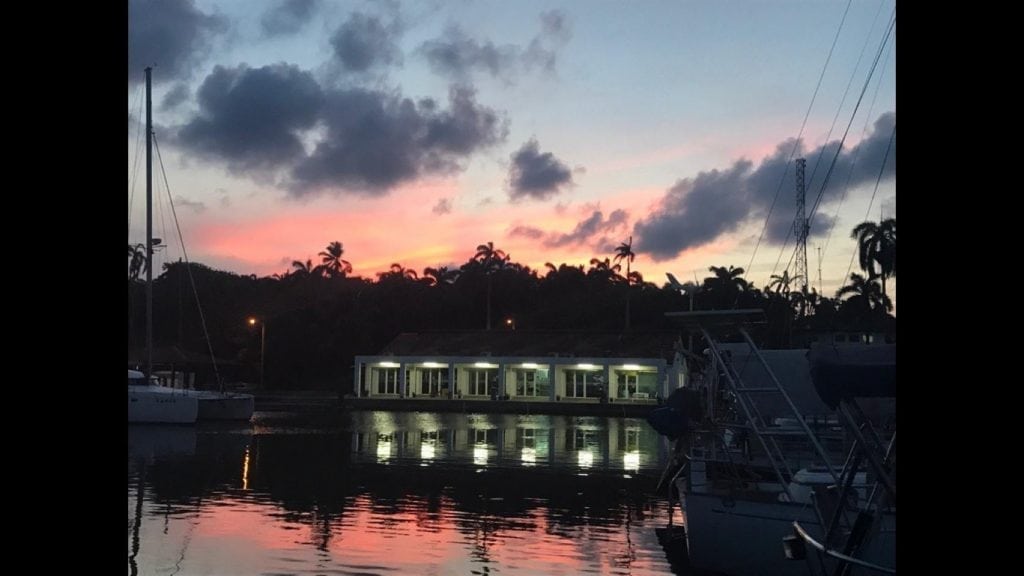 05.30 There’s too much in my head to fall asleep again so I get up, make strong Greek coffee for two and go out in the cockpit. A lighting strikes in the twilight and then too more. The ITCZ , the Intertropic Convergeance Zone is near Panama by now. The overcast sky is turning purple. The birds are singing. The water is tranquile, mirroring the clouds. The tropical forest that lies behind the marina buildings is full of sounds. Sdenly, the birdsongs are covered by the loud roar of a howler monkey. I am greatful. Our eyes rested on the green color for over a month, here in Shelter bay marina. We are ready for the big blue now. The world is beautiful
05.30 There’s too much in my head to fall asleep again so I get up, make strong Greek coffee for two and go out in the cockpit. A lighting strikes in the twilight and then too more. The ITCZ , the Intertropic Convergeance Zone is near Panama by now. The overcast sky is turning purple. The birds are singing. The water is tranquile, mirroring the clouds. The tropical forest that lies behind the marina buildings is full of sounds. Sdenly, the birdsongs are covered by the loud roar of a howler monkey. I am greatful. Our eyes rested on the green color for over a month, here in Shelter bay marina. We are ready for the big blue now. The world is beautiful
7.30 The marina net broadcast starts and Yorgos turns the volume up on the new VHF that we installed at the cockpit. We are so glad we can now hear the VHF loud and clear at the cockpit, we were looking forward to do it for years. Actually, we did a lot of work on Filizi since we arrived in Shelter Bay and most of it by ourseslves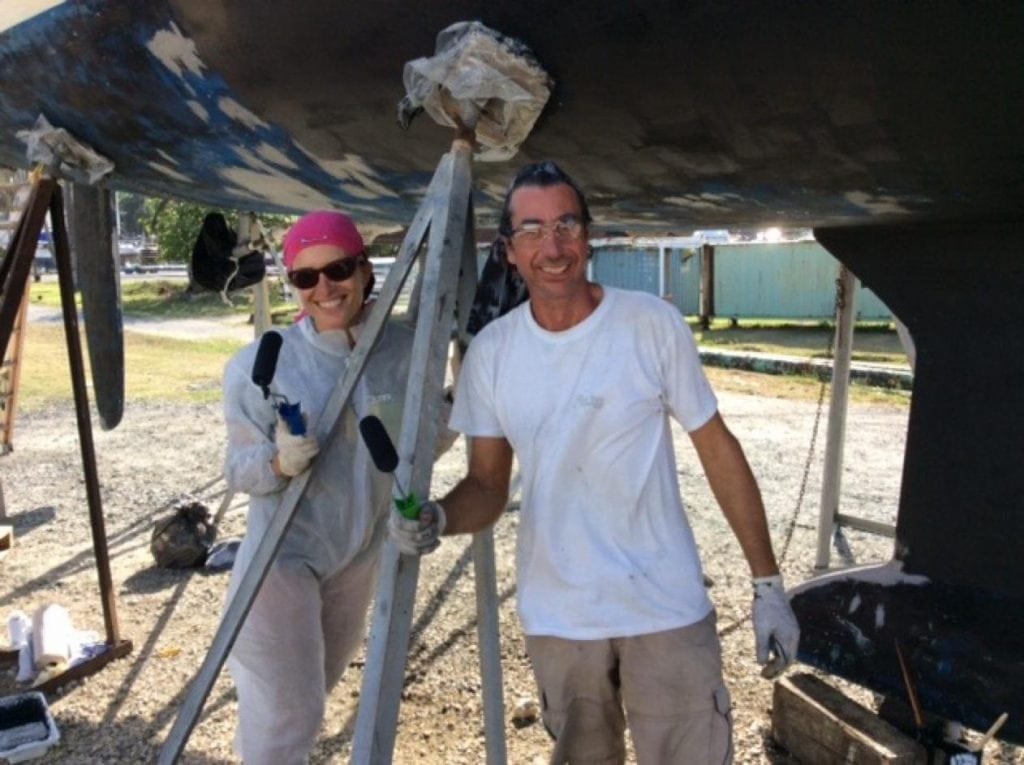
- Hull cleaning and painting of new antifouling
- New valves on the hull
- Service of Yanmar engine, new impeller, and oil change
- New exhaust on the generator
- Cleaned the fuel water separator and changed its filters
- Reinforcement of the radar column with a stainless steel tube and stainless cords
7. Cleaning, oiling and new calulking on the teak deck
- Installed a new VHF in the cockpit For this we had an electrician
- Repair of our second refrigerator . This was done by Greg
10. Repair the Yanmar engine Hitachi Alternator, by technicians in Colon
- Sanding and varnish of Filizi removable wooden floor
- Making the windows watertight again with Sikaflex
- Cleaning of the fuel tanks
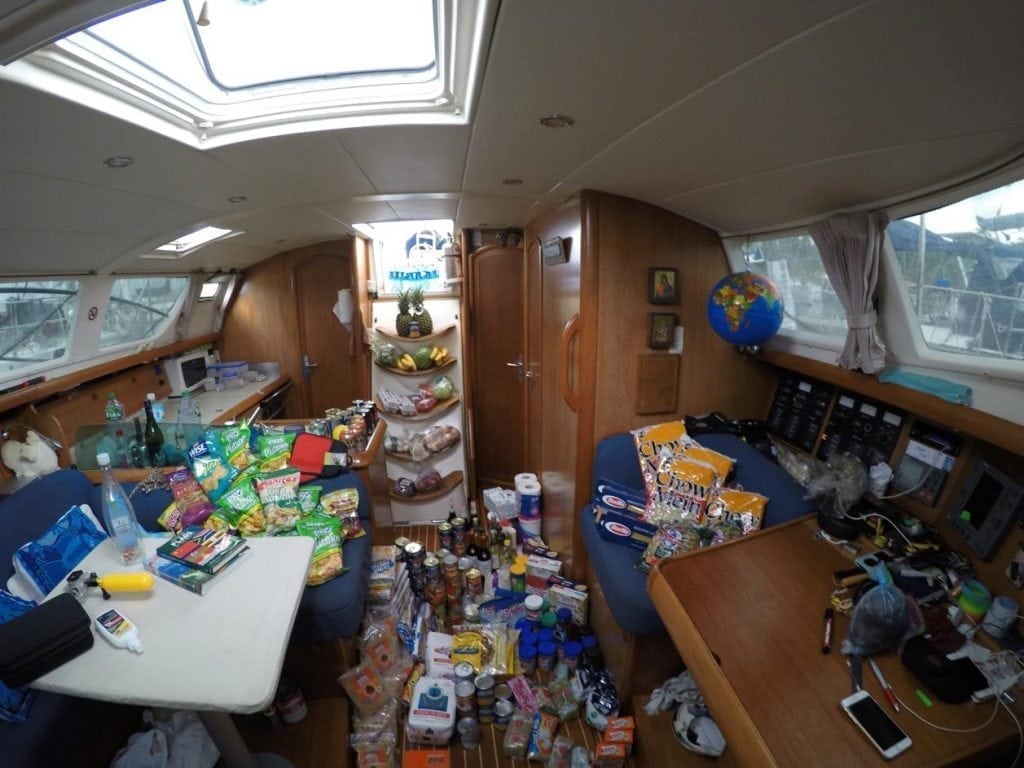 And last but not least, we bought, carried and arranged food provisions for the next five months. A lot of work. We still have work to do. Yesterday with the heavy rain there was a leak from the hatch on top of the superstracture. This must be fixed today and I wonder how…
And last but not least, we bought, carried and arranged food provisions for the next five months. A lot of work. We still have work to do. Yesterday with the heavy rain there was a leak from the hatch on top of the superstracture. This must be fixed today and I wonder how…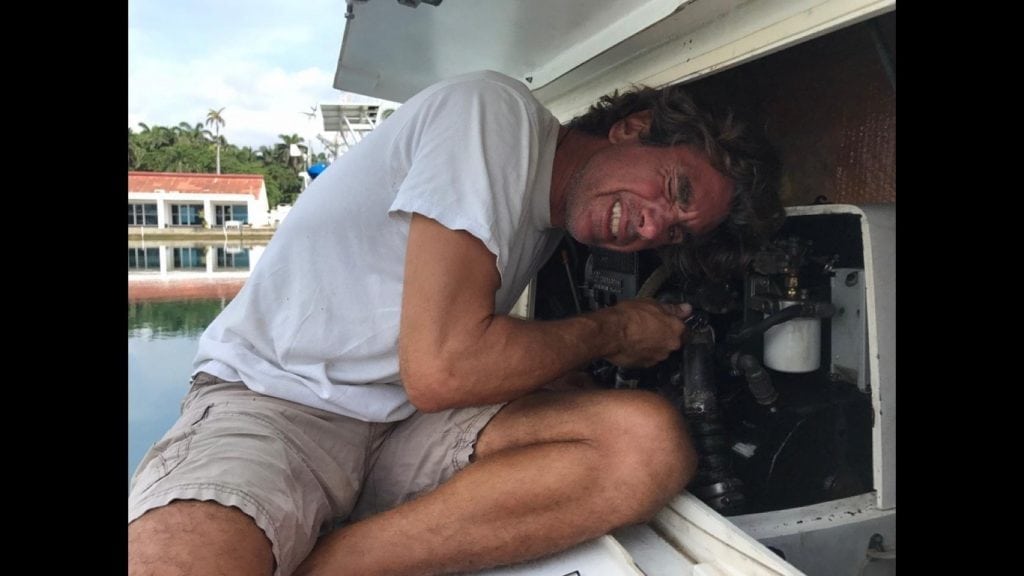
-“…and don’t forget to come about 5pm at the Sailors Palapa, bring your drink and a snack to share….”, continues JoAnne on the net, with her sweet and sexy voice. There are daily social events in the marina. If one has time and energy to participate, that is. Filizi crew has been too busy.
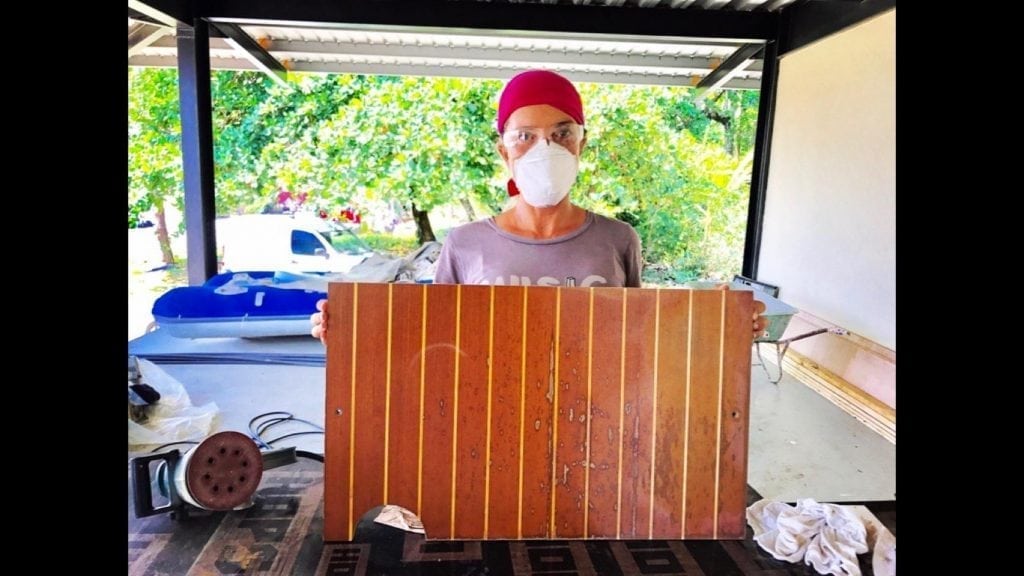
-”I thing the last load of pasta in the deep freeze should be ready by now. It’s been in there for three days. Time to take it out.” Yorgos says. We put all our provisions of pasta, rice and flour in the deep freeze to kill the bugs and their eggs.
I follow him inside and turn off the freezer fuse. He opens the freezer door and starts taking out the packs. I really hope this trick works. The tropical climate makes bugs grow in pasta in 4-5 months. I wipe the cold and moist packages with a dry towel
-“We have to arrange all this, somehow. Any ideas? ” I ask, looking at a pile of 45 packages of pasta and 15 packages of flour on the sofa. The cupboards are already full. We never, ever, had so much provisioning on the boat. We are a floating grocery shop. Filizi has never been so heavy…
-“ When the ice melts, we’ll put the freezer on refrigerator mode, keep it in a medium temperature to save energy and use it for the fruit and vegetables. I believe our batteries can sustaint the second refrigerator, for a few days” Yorgos says.
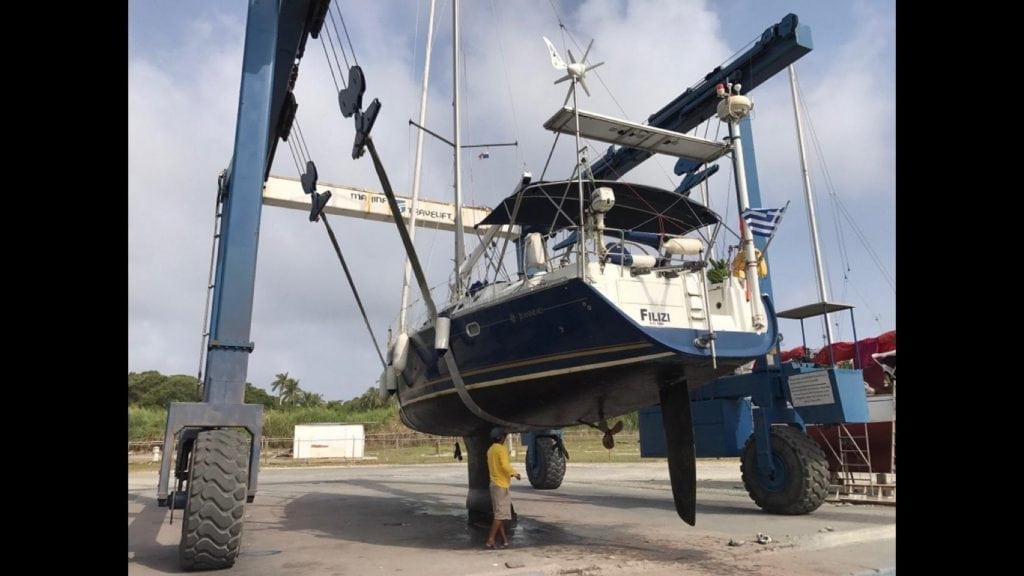
11.00 As Yorgos gathers the necessary tools for the hatch repair, we hear a thump from the deck, above . I peek from the window and see two local guys piling thick, blue lines and big fenders on the deck. These four strong lines, each of them 50 meters long, will be used for the Canal transit, tomorrow. We both hurry out. Peter, the assistant of our agent for the transit, is standing on the pontoon by Filizi.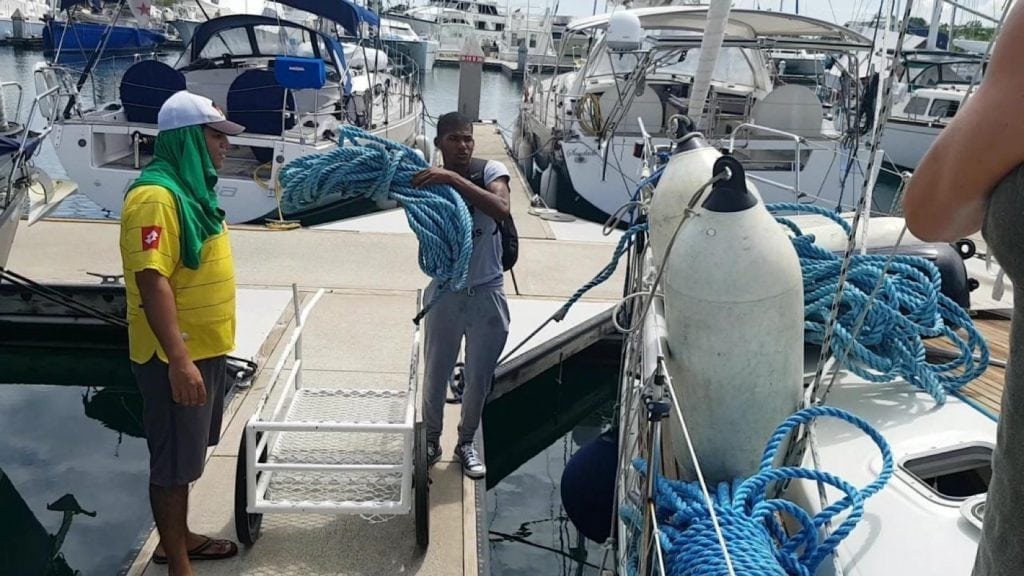
-“Hola, buenos dias! Eric, the agent, has sent you and email, I don’t know if you saw it. Tomorrow’s transit is postponed” he says.
-“Why? What happened?” we say in one voice and I check the emails on my cell phone. I see Eric’s email and open it. Before I have time to read the email, the agent calls and tells us the bad news. Some of the transit advisors didn’t show up for today’s transits, so they are all postoned one day later. He says he’ll come tomorrow to bring our “Zarpe”, our clearance from the country. We stay speechless for a while.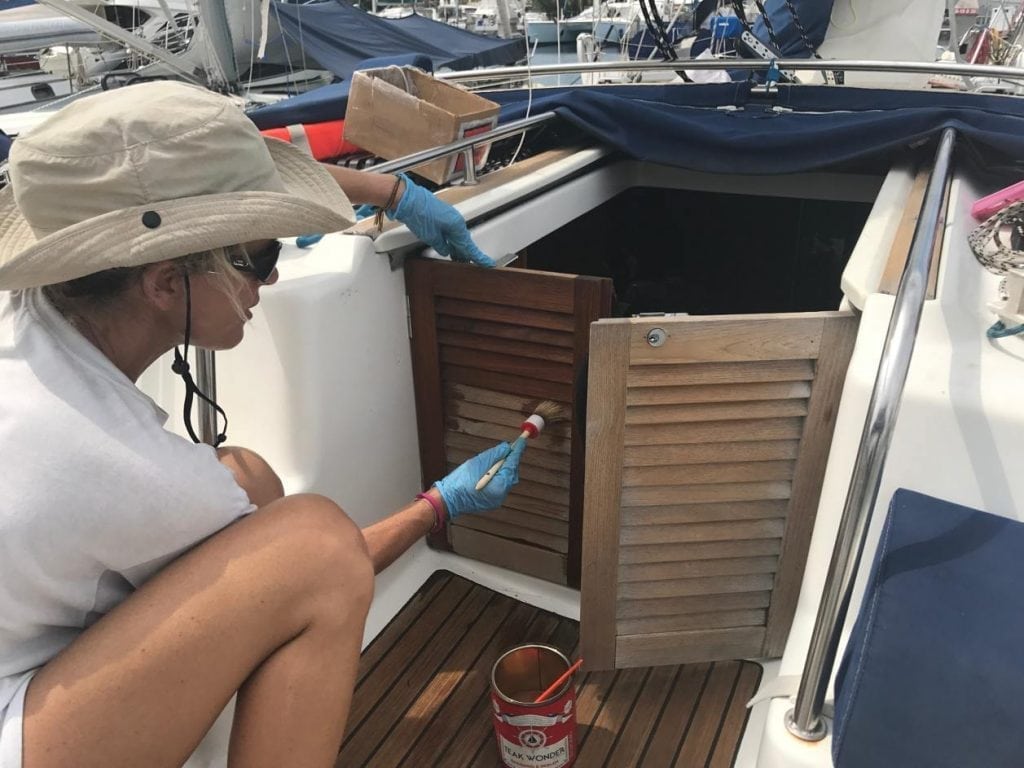
-“OK, there’s no harm done. We’ll even have time to finish and upload our movie (Sailing Filizi to Panama)” I say to Yorgos.
-“Yes, no problem at all. I even feel relieved, as the repair of the hatch troubles me. It is a mind game this mechanism and even though I’ve talked to several people, no one seems to know how it works” Yorgos says, and his mind is already flying to the Goiot hatch. 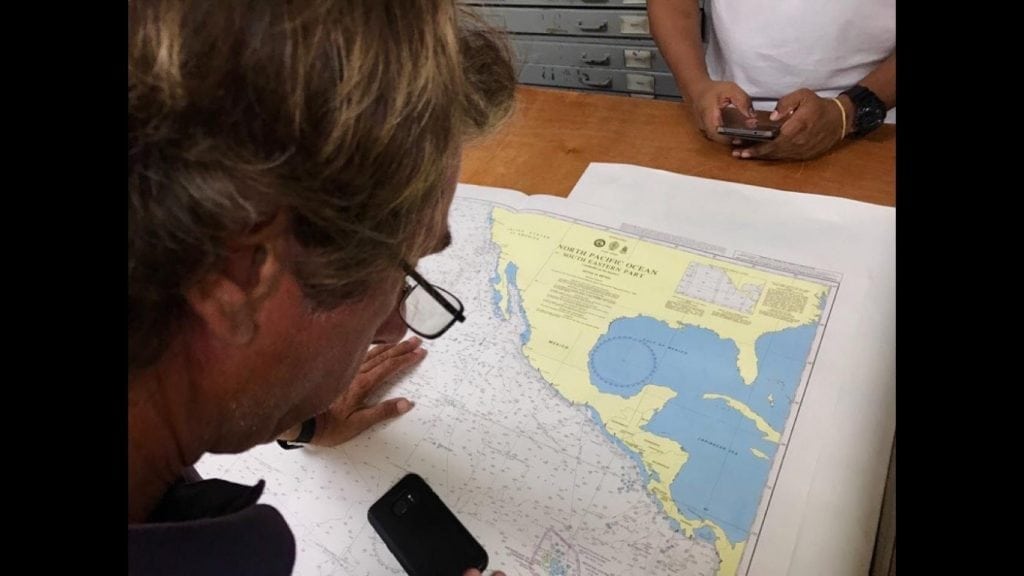
We go back inside and I open the freezer to check the temperature. I want to put my avocados inside, I worry about my precious avocados. The metal plate in the fridge is totally warm. I turn and check the fuse: the fuse is on.
-“There’s something wrong here, the freezer isn’t cold”. Yorgos opens the small cupboard where the refrigerator compressors are. Greg the mechanic, “the engine whisperer” as he calls himself, fixed it, just ten day ago.
-“Not again…” Yorgos says. I’ll call Greg to come and check it out”
-“ Good. I’ll go tell John and Frances the transit is postponed one day” I say and jump on the dock. We met Frances and John a couple of weeks ago, here at the marina and we liked them immediately. They come from Australia, actually Frances is from New Zealand. They own a 47 ft Beneteau and are experienced sailors, they sailed from the Caribbean to Australia some years ago and last week they started to Australia, once more. Unfortunately, when they reached Gatun Lake, their boat’s engine overheated, and they were forced to return to Shelter Bay marina for repairs. Bad luck but maybe it was for a good reason. Now they have time to see Guna Yala and Bocas del Torro, both amazing places, before starting to Australia again, next year. So now, they are coming to help our Panama Canal Transit as line handlers, and we are really happy for that. They are both adorable.
12.00 Coming back to Filizi I find Greg “the engine whisperer” and Yorgos bending over the compressor.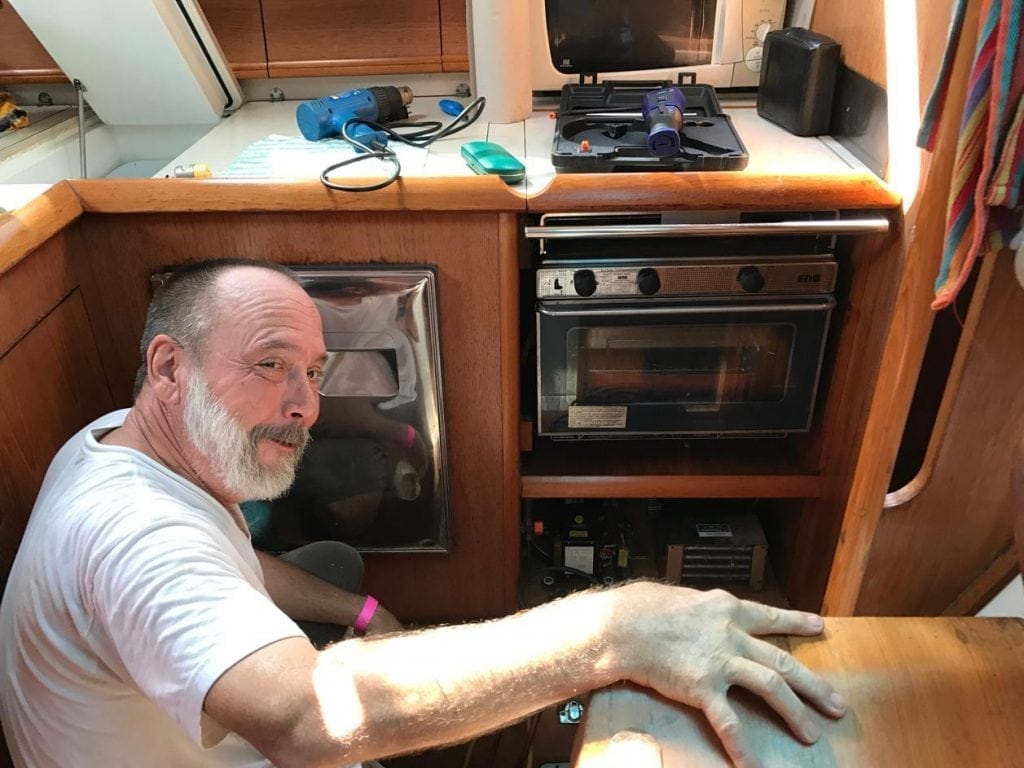
-“What’s your opinion doctor”, I ask the mechanic.
-“The patient is dead”, Yorgos answers with a sad tone in his voice. As the mechanic collects his tools I ask what caused the refrigerator to stop working but there’s no explanation.
-‘The compressor is finished, capout. It’s not strange, it’s already 16 years old. I’m sorry” Greg says. He patiently gathers his tools and leaves us
-“You could buy a portable one you know. Think about it. It’s a good solution” he says as he walks away on the pontoon. When we are left alone we can’t figure it out. The voyage ahead is long, very long. But we have to move on.
-“John is coming to help with the hatch” I say to Yorgos to change the subject. We’ll have to deal with the issue later.
16.00 Yorgos is changing the deck hatch pins, with John’s and my assistance. I’m filming the process with my mobile,. Yorgos has figured out how the mechanism works but not how the new friction pins can be installed. After one hour the first pin is in place.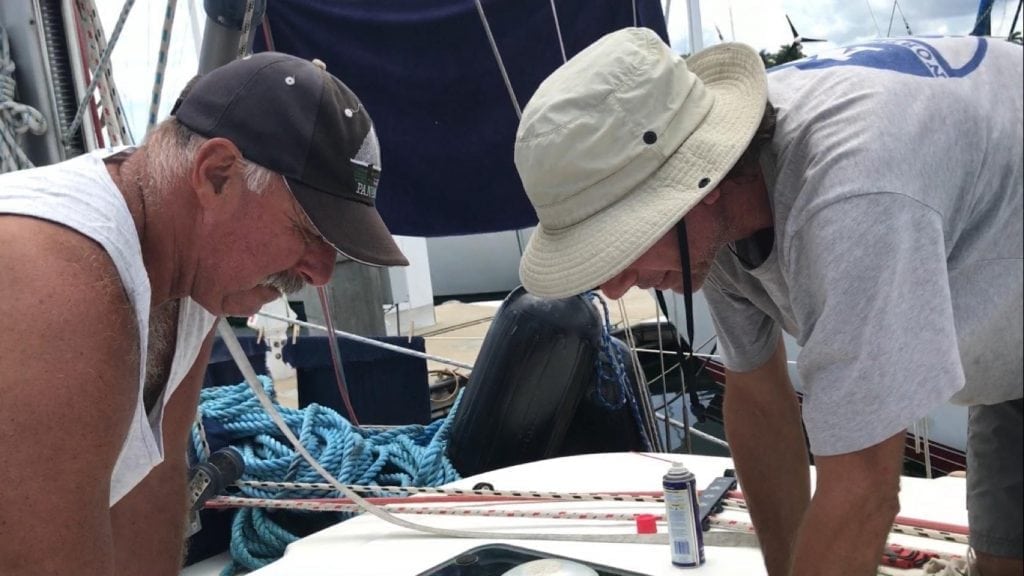
-“Five minute job!” Yorgos jokes
-“ That was easy!” John says.
-“It’s the expertese that counts, John”, Yorgos says
-“After five or six gos you get it right and you think “that was easy”! We have a button at home, we keep on the fridge, which we had on the boat, some girls gave it to us. It’s a little red button. As you go past it, after you have finished a job you press it and it goes “That was easy”. Even if the job took three hours.
We all laugh. One more pin and the hatch works like it used to, years ago.
That was easy!
Wednesday May 10, 2017
The Panama Canal transit
03.30 I open my eyes and get out of bed. I need to check if our movie – Sailing Filizi to Panama – is uploaded on youtube. The wifi in the marina works well only at night, when everyone is asleep. I check the iphone screen: the upload has failed. I take my phone and go outside to the cockpit to try again. As I do that, I see my friend Valeria online – in Greece it’s eight hours later- and we start texting. I miss her, I miss my family and my friends but I wouldn’t change anything in my life, right now. I sit back and look at the silent, peaceful night. A lightning breaks on the sky above. The moon is hidden by thick clouds. A jumping fish splashes on the water and a howler monkey roars. I breathe deep. Today Filizi will transit the Panama Canal, transit across the continent into a new ocean, the Pacific. The canal fashinates me. In the little free time I have these days, I read the book ”The path between the seas”, about the events between the years 1870 and 1914, that lead to the building and completion of the Panama canal. David Mc Cullough, the author of the book writes:
“The creation of the Panama was much more than a vast, unprecedent feat of engineering. It was a profoundly important historic event and a sweeping human drama not unlike that of war. Apart from wars, it represented the largest, most costly single effort ever before mounted anywhere on earth. It held the world’s attention over a spam of forty years. It affected the lives of tens of thousands of people at every level of society and of virtually every race and nationality. Great reputations were made and destroyed. For numbers of men and women it was the adventure of a lifetime. Because of it one nation, France, was rocked to its foundations. Another, Colombia, lost its most priced posession, the Isthmus of Panama. Nicaragua, on the verge of becoming a world crossroads, was left to wait for some future chance. The Republic of Panama was born. The United States was embarked on a role of global involvment…..”
05.45 Yorgos calls from down below.
-“Kalimera! Where are you?”
-“Kalimera! Would you like some coffee?”.
We are both in a fast mode. Yesterday we made some more provisioning and the editing of the Sailing Filizi to Panama, a 30 minute movie and a second shorter version of 15 minutes. I worry that if something happens we may lose all our photos, so with the movie we have something. 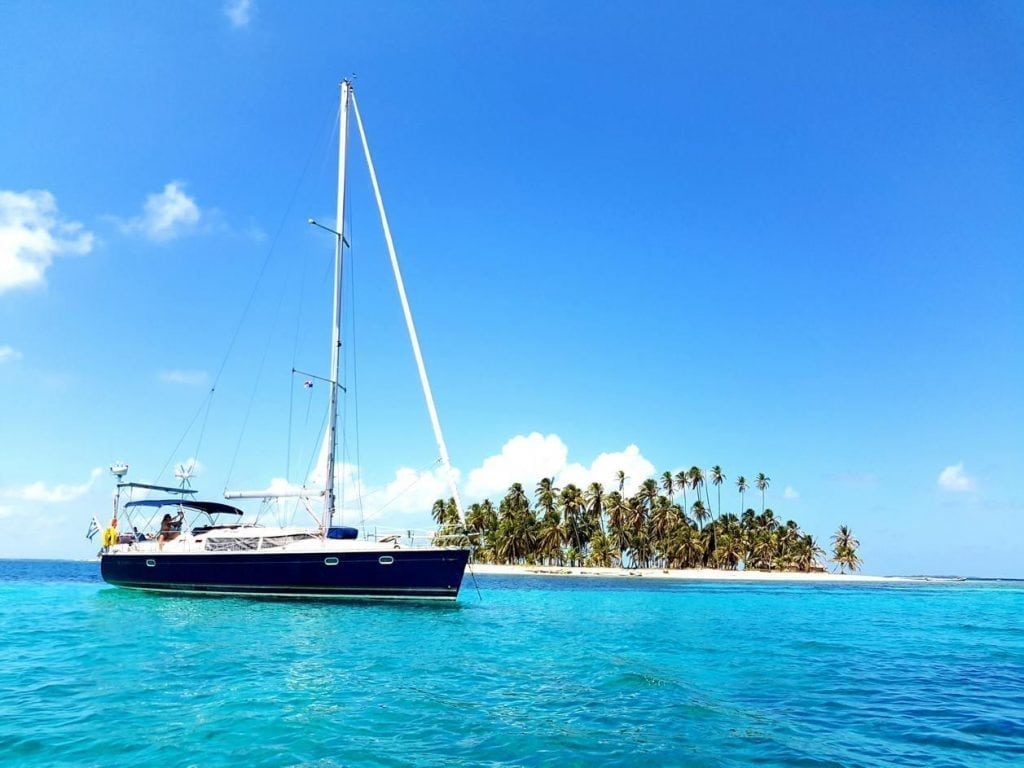
We take the coffee mugs and go to the cockpit. Lightnings illuminate the clouded sky at the southwest.
-“So, we are leaving today. We are transiting the Panama Canal again but, this time we do it with Filizi. Imagine that…” Yorgos says. This will be our second transit, as we helped a 76 year old single handed sailor , Partic Calahan to transit the canal with his boat Traveller on April 14th.
-“It’s strange, we’ve been working so much that I haven’t had time to think about it. The Panama Canal, the Pacific Ocean. It all seems unreal. All I can think of is today. Tomorrow is too far away. “
There’s still a lot to be done, provisions to be arranged, the marina bill to be settled, silicone is needed on the front window cause there’s a leak, the water tanks to be filled, the boat to be cleaned, and food to be prepared. We will be six people on board today: John and Frances, a line handler, arranged by our agent, and the transit advisor, authorised by the Panama Canal to monitor the transit.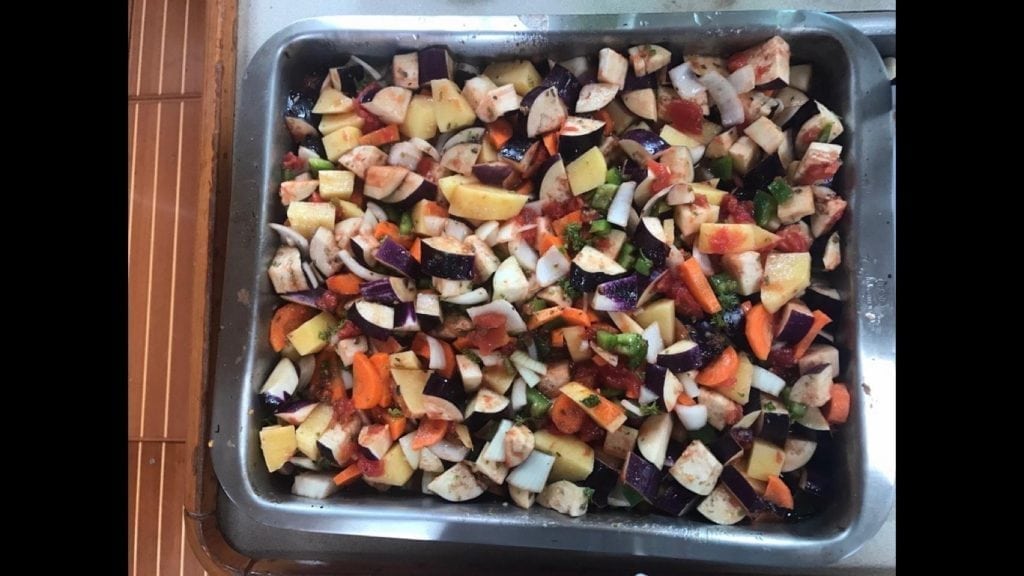
12.00 The food is ready, tuna salad for sandwiches and briam (ratatoulle) for dinner. The boat is tidy, clean and cabin A is prepared. If the weather is rainny, the line handler may sleep on the couch. The silicone at the windows is drying. I hope it doesn’t rain. It’s so hot today
12.15 “The line handler should be here any moment, now. There’s no time to waste” I think as I continue arranging things for our departure. Then, a pouring rain starts. We run out to take down the awning, before it’s soaked. The rain lasts for 10 minutes. Hopefully the silicone would have dried by now, it’s been two hours since Yorgos put it. The window stopped leaking though and that’s a good sign. Things have been going wrong today. A while ago, Yorgos turned the watermaker on, as he does every day and he saw an alarming reading on the pressure gauge. The membrane may be damaged. We are alarmed, but there’s not much we can do right now about it. Now he’s is filling up the water tanks . I notice water flowing from the bildge hose.
-“Yorgos! There’s water runing from the bildge!” I tell him.
-“Damn!” He hurries down below and opens the bildge cover: the bildge is flooded with water. He lifts a second wooden cover to check the water tank. From a crack on the top of the tank, water is flowing out with presure.
-“ Damn! That isn’t good! We must empty the tank a little”, he says and he turns the galley tap to let water run
-“Easy. I was trying to find time for a visit to the marina showers. I’ll have a quick shower here … Maybe you should talk to John” I say
-“Good idea, I’ll go find him. You empty the tank, say for twenty litters” he says and goes. The water tank broken and the watermaker not working well. I don’t even want to think it about the concequences of all that.
12.50 As I finish my shower and get dressed everyone, Yorgos, John, Frances and the line handler come on board Filizi.
-“Hola!” I greet them and help the line handler with his back pack. John opens a box and takes our two bottles, the epoxy and the hardener. He makes the mixture and Yorgos applies it on the hole of the water tank. Luckily the crack is on the top and it’s easy to reach. The repair is done and we cross my fingers for it to hold.
13.00 -“Time is up. We have to go to the Flats. Let’s go!” Yorgos says , starting the engine. I turn on the instruments and wear my sailing gloves. We untie the lines and start! Fellow sailors on the pontoons, salute us
-“Good buy Shelter Bay! Hope to see you again” I say looking at the beautiful place we leave behind.
-“Goodbye Shelter Bay!”, Yorgos says.
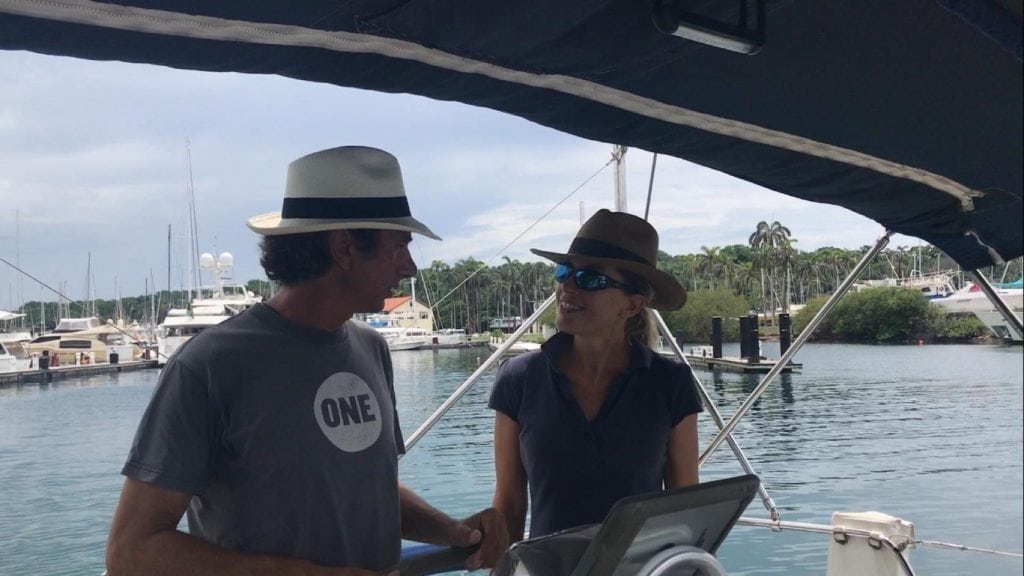
17.00 We are anchored at the Flats, the anchorage close to the Cristobal harbor, before the entrance the Canal locks, waiting for the transit advisor who will be here any minute. We are monitoring the traffic on the VHF . Three other vessels, two sailboats and a motor yacht are anchored close to us.. Juan, the 22 year old line handler, John and Frances are oranising the lines
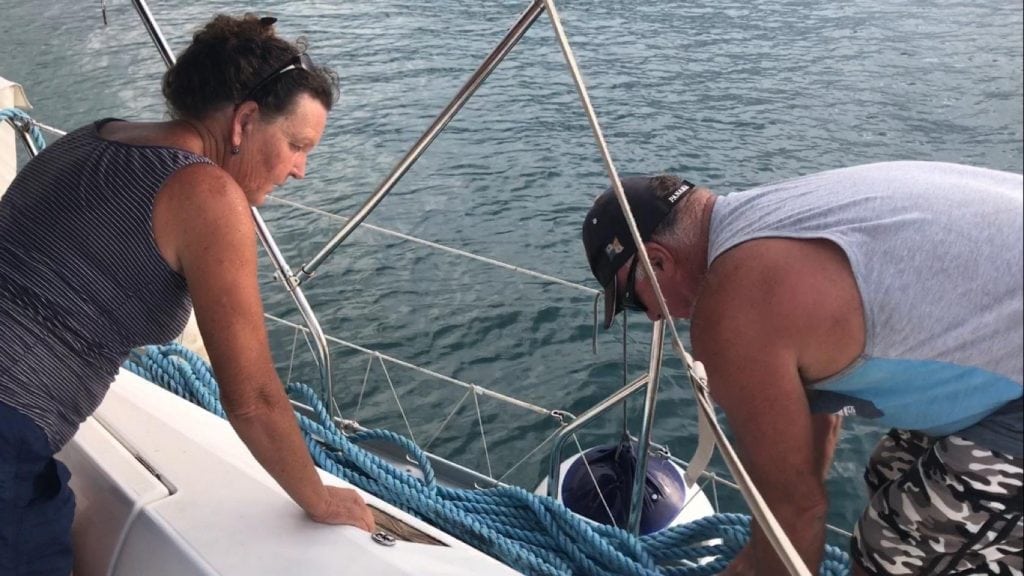
-“Tell me , Juan, how many times have you transited the canal?” I ask the young man
-“Until now, I have 250 canal transits.” he answers.
-“ You look too young, to have transited so many times!i say
-“250 and a half for the transit you did with us” , John jokes. Juan was with John and Frances at their unsuccesfull transit.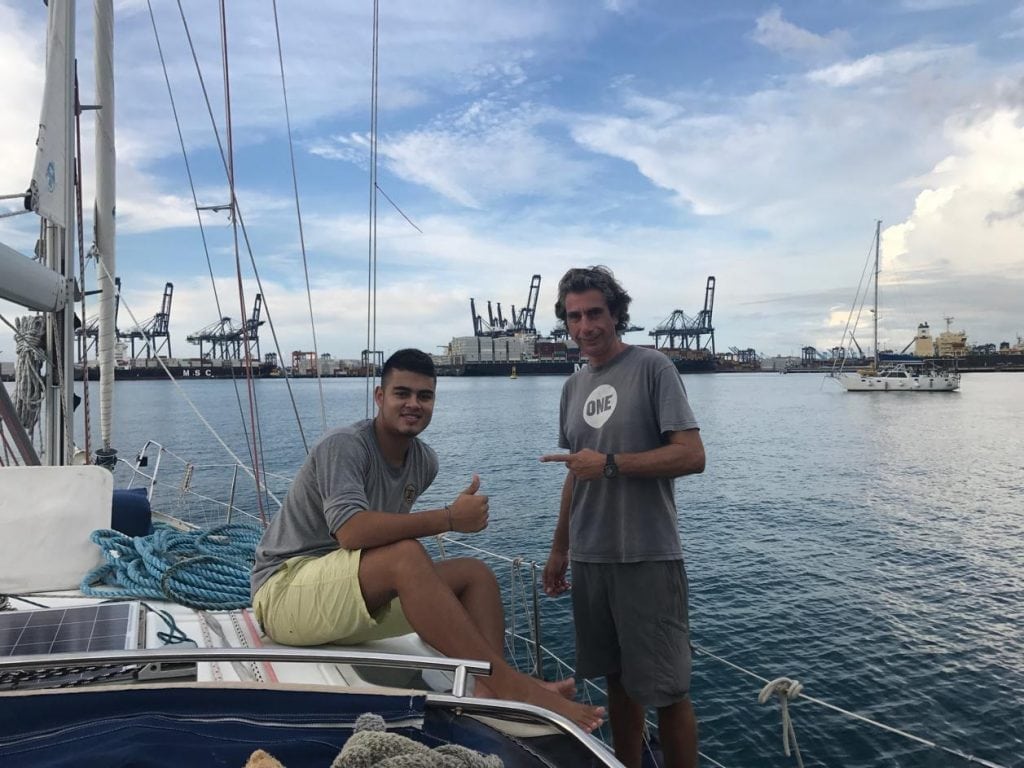
A pilot boat approaches and manouvers to let the advisor off.
-“Welcome, my name is Yorgos” my captain says and shakes the man’s hand
-“Nice to meet you. I am Reggie” the man says. He puts on the special handheld VHF all advisors have and informs the Canal that he’s onboard.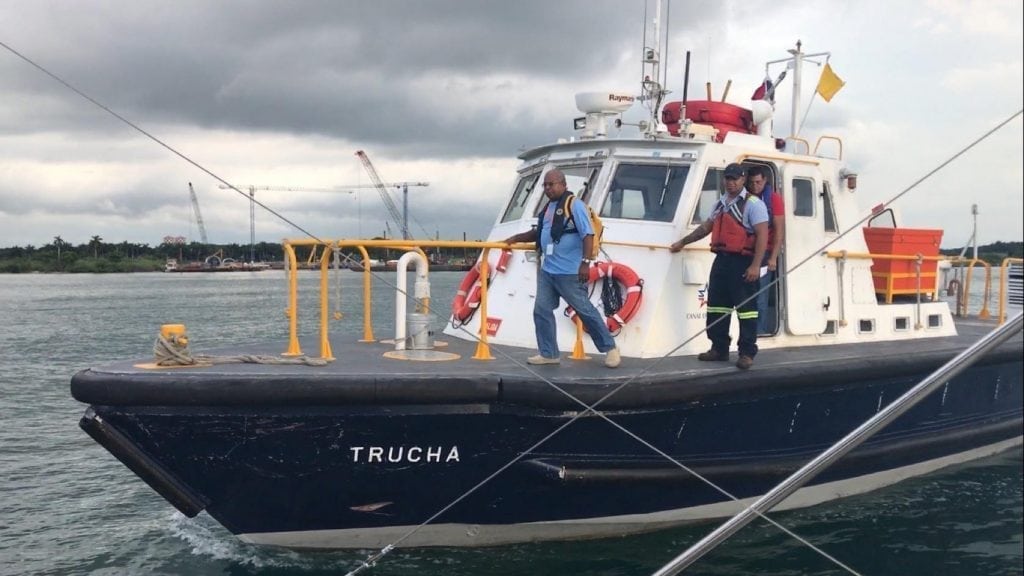
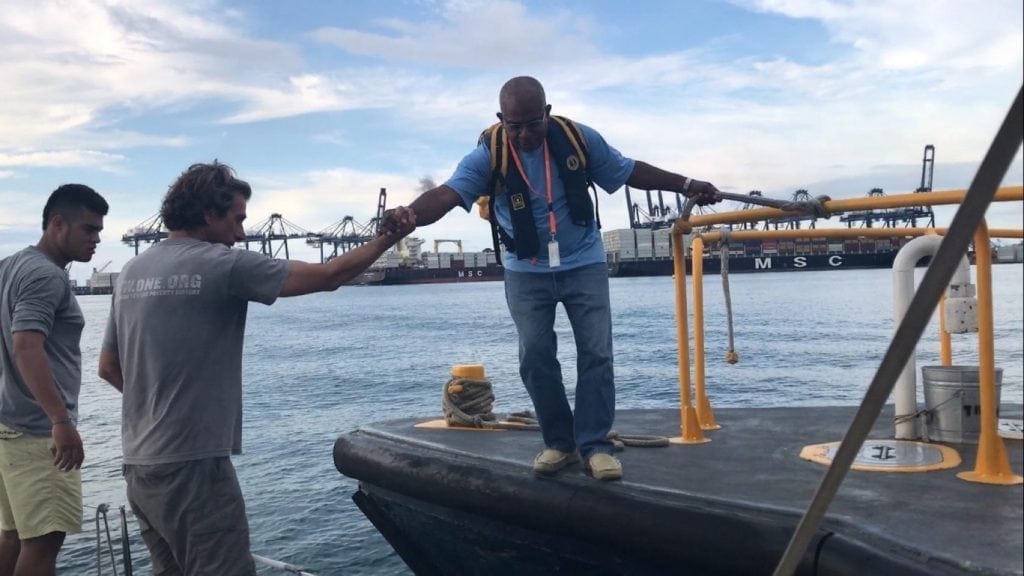
-“We’ll make the transit, tied on the side with two more boats, the motor boat and the sailboat Utopia. And now we should get going“ the advisor says.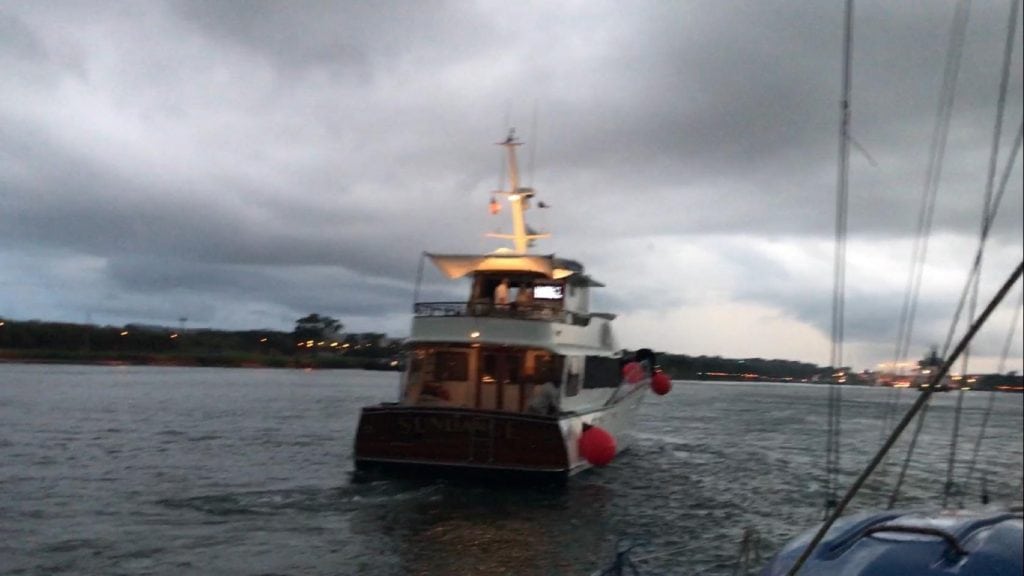
I go to the bow and take the anchore up. My heart pumps. Here we go…
18.15 We are motoring with 6,5 knots speed towards the entrance of the Gatun locks. The sun sets and dark clouds cover the sky above.
18.30 As the sky gets dark, Yorgos notices that the engine alternator light is on.
-“There’s something wrong with the alternator. Karina stay at the helm, I’ll go and check if the batteries are charging” he says . He goes down and looks inside the engine room.
-“The alternator doesn’t work. We must send an email to the marina” he says. One more problem to solve. We serviced this Hitachi alternator three weeks ago, and paid a fair amount for this. Something went wrong. We do have a spare, but we need to have them both working for the Pacific passage. Also the proceedure to put it in or out is very difficult. Poor captain Yorgos, your troubles are endless.
18.45 As we enter the Approach Chanel to the Gatun Locks a pouring rain starts falling. The Gatun locks ahead, a three step elevation 26 meters above sea level to enter the Gatun lake are brightly lit. Each lock is about 320 meters long.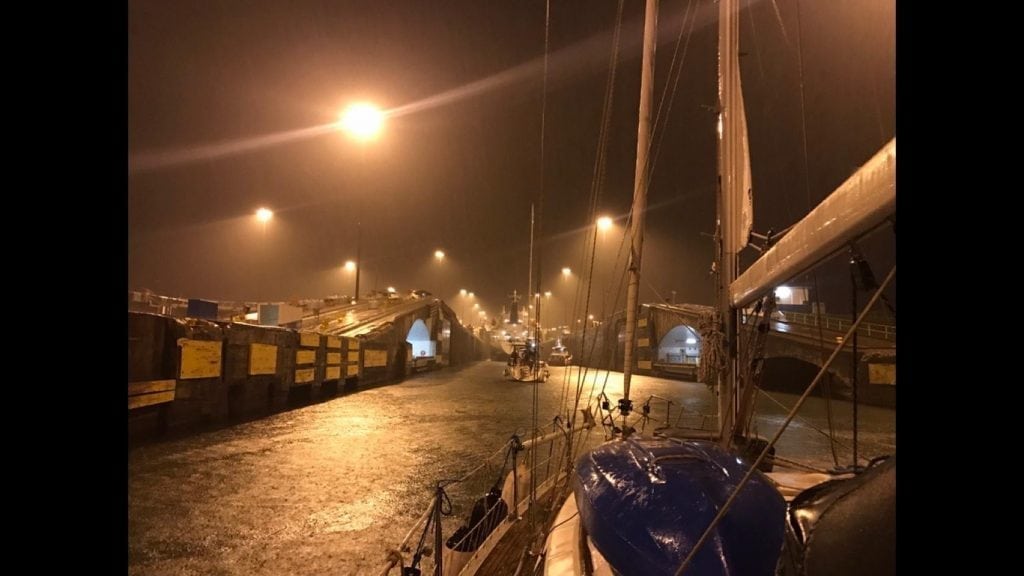
19.00 Entering the channel, all three boats come close and we tie together with the strong blue lines. First is the motor yacht, tied starboard to the canal wall, second the steel Utopia boat and to its port is us, Filizi. We enter the first lock. Ahead of us transits the cargo ship “Everest bay”. I wonder where this “bay” may be.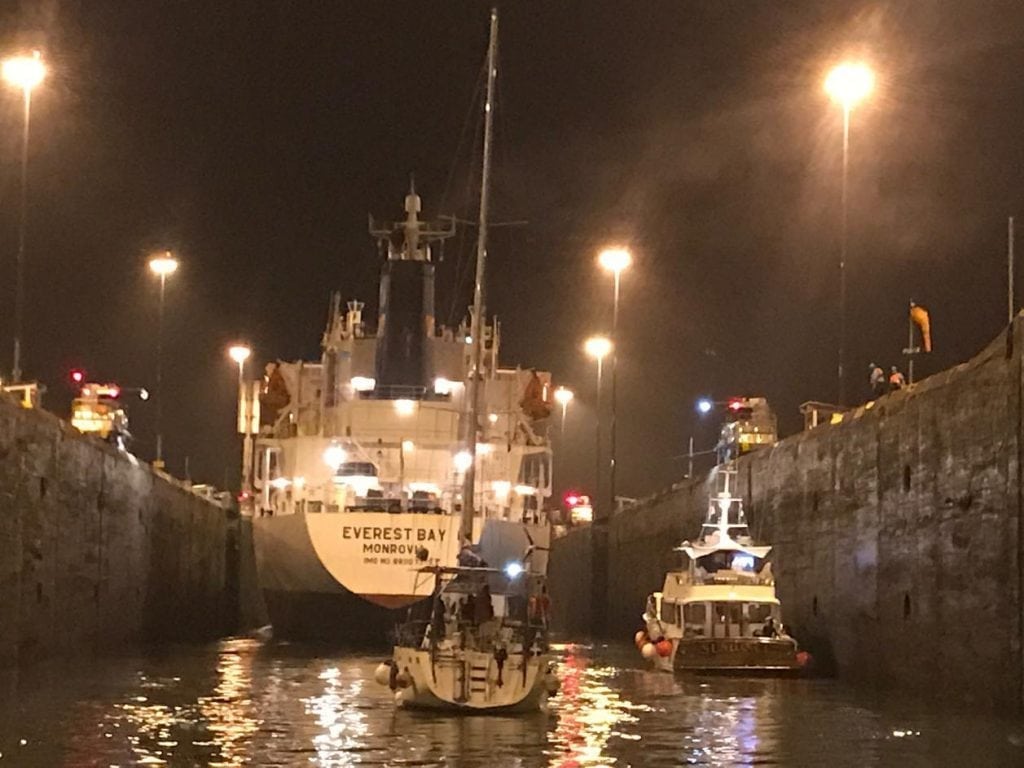
The huge 103 year old doors close behind us and the lock starts filling with water, carried from the lake. 101.000 cubic meters of water will be needed for each lock to fill up and lift the boats to the next level. The flow of the water is strong and big eddies are formed and we feel the strong turbulence. The rain keeps pouring but our spirits are high. John and Frances are handling the lines in the bow and Juan in the back. John is soaking wet, he didn’t have time to wear the oils I offered, but he didn’t mind either. Lightings illuminate the sky.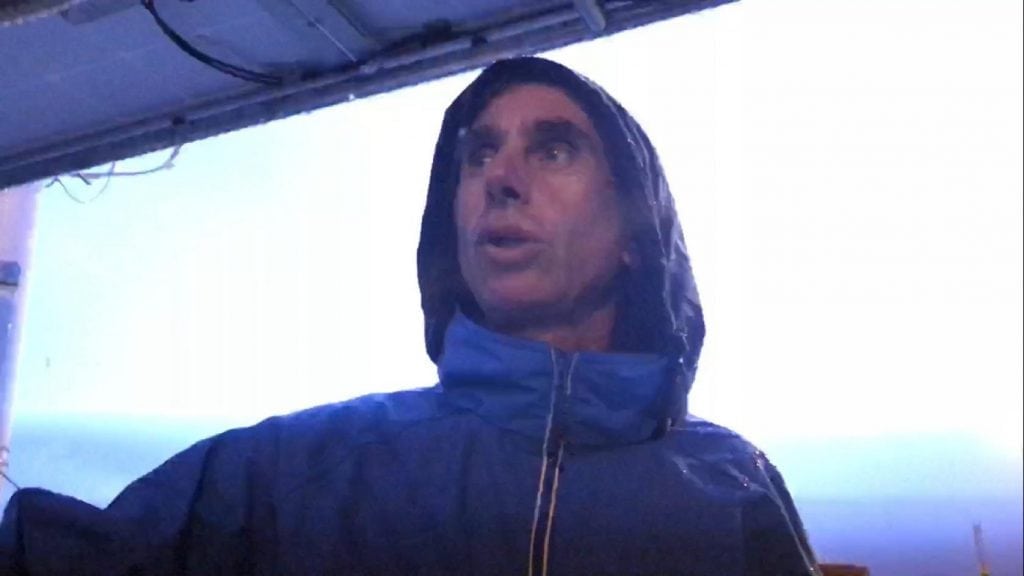
-“ This is a very good rain!” the advisor says. “You see, we need the rain to fill up the lake. Fortunately the new locks have special water tanks and save the water of the locks for multiple uses…”, he adds.
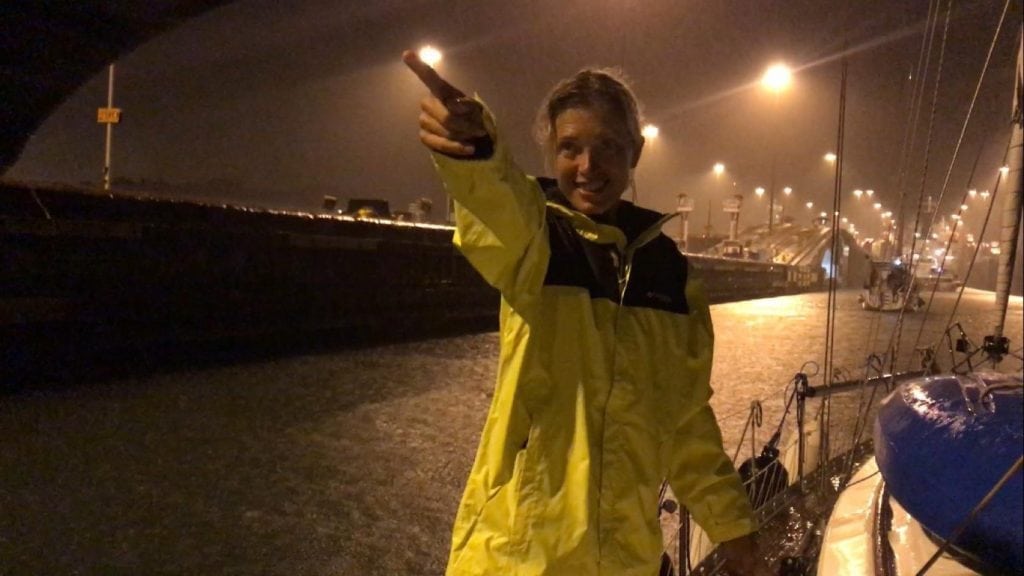
After ten minutes, the water level has risen 8 to 10 meters and is equal to the next lock. We untie from the other boats and proceed separately to the next lock. We are all thrilled! When the motor boat takes position on the wall, first Utopia and then us, we tie together again, with four lines, one aft, one at the bow and two spring lines. When we are all set, a horn starts blowing and the steel doors behind us close slowly. One more lock farther from the Atlantic. Each lock behind becomes a barrier, each lock ahead a promise. There’s no turning back now. The only way is the Pacific.
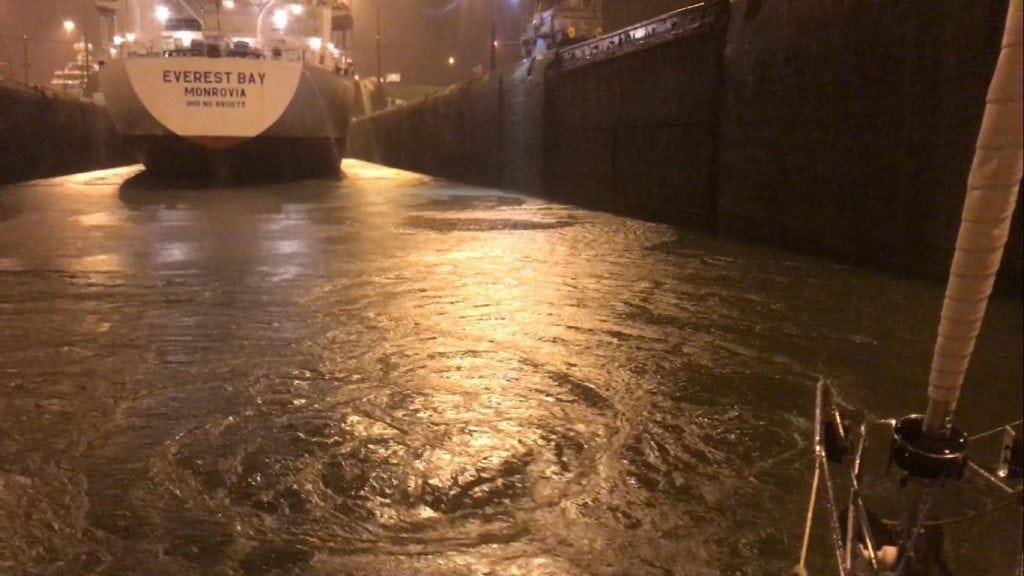 19.40 The rain stops. Everything is clear, clean and glossy. There’s a scent of freshness and optimism in the air. Frances and John at the bow do a great job, and they seem to enjoy themselves. They have transited the canal nine times with friends, so they know exactly what they are doing. The water is filling the lock, and the turbulance is so strong that all three boats turn.
19.40 The rain stops. Everything is clear, clean and glossy. There’s a scent of freshness and optimism in the air. Frances and John at the bow do a great job, and they seem to enjoy themselves. They have transited the canal nine times with friends, so they know exactly what they are doing. The water is filling the lock, and the turbulance is so strong that all three boats turn.
-“Yorgo? Is everything OK?” I ask my captain.
-“Don’t worry Karina, there’s no danger” the advisor says with a comforting smile.
The water level is rising, minute by minute, and the high walls around us, become smaller and smaller. The system works impecably and the transit is smooth. On the wall that separated our lock with the paraller lock of the oposite lane, a small train moves on the tracks, one of those that pull the big ships. It looks like a toy.
A few minutes pass and then a bell rings and the doors ahead start to open. One more lock and we reach the Gatun lake.
_”That was easy!!” go Yorgos and Jonh….
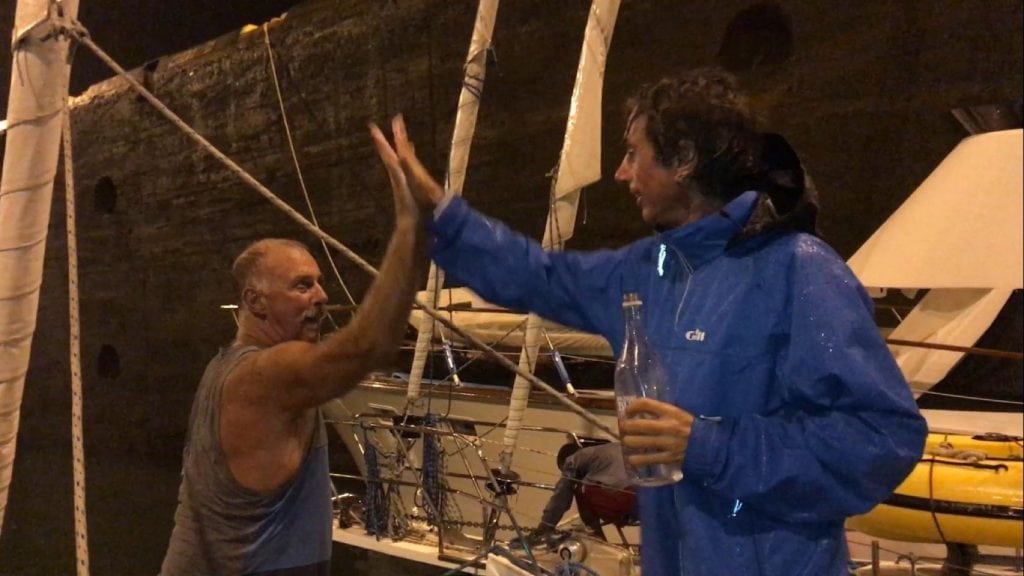
23.00 We are tied on a big, red rubber buy at the Gatun lake. On the other side of the buy is the Brazilian boat, Utopia. We all had dinner and everyone is gone to bed. It’s raining again. I’m excited but I need to sleep, My eyes are heavy.
Thursday May 11, 2017
09° 11 N 79°53 W Gatún Lake
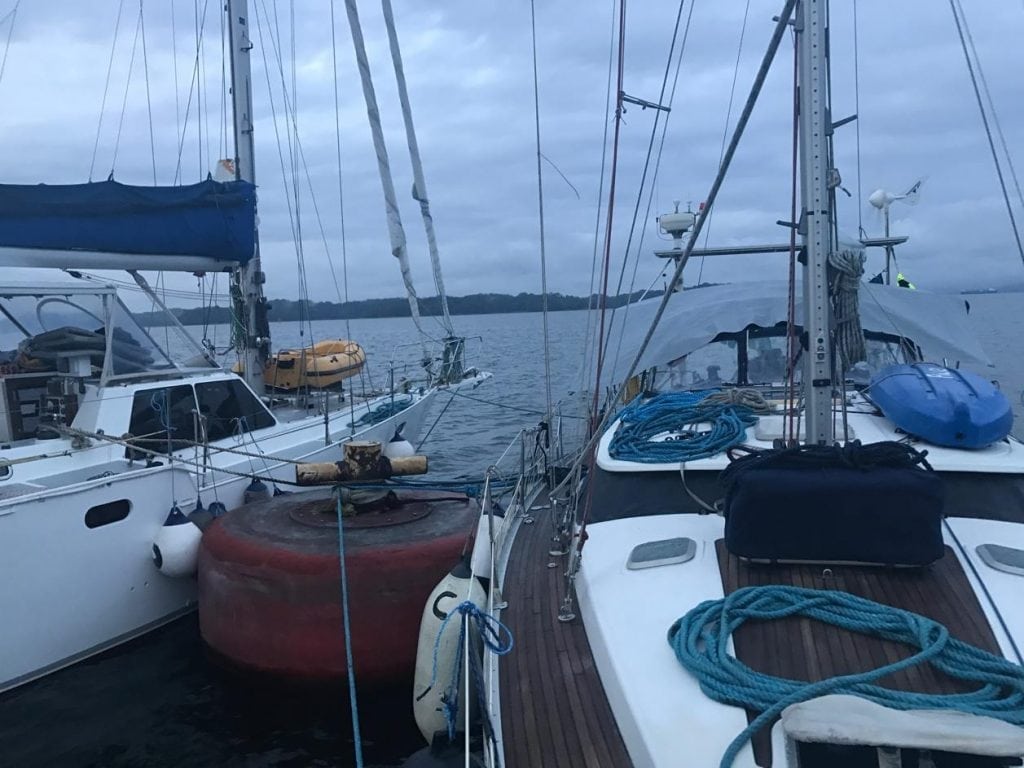
05.45 The alarm on Yorgos cell phone starts. The advisor said he’d arrive today at 6 am.
-“Kalimera baby!”
-“Kalimera my love! I’ll go make some coffee” Yorgos says.
I peek outside from the small window on the side of the hull. In the morning twillight, I see a huge ship, probably Neon size, cross the lake, heading for the new locks and then to the Pacific Ocean. The Gatún lake is a large artificial lake, created by the building of the Panama Dam across the Chagress river. It is a major part of the Panama Canal and carries ships 21 miles (33 klm) to the other side.
I quietly get out of bed and get dressed. Juan, Frances and John are still asleep. I go out to the cockpit and hang the wet clothes to dry. The Brazilian people of Utopia are awake, too. The song of the tropical birds is happy and loud. A black bird lands on Utopia, strolls around and then comes to Filizi.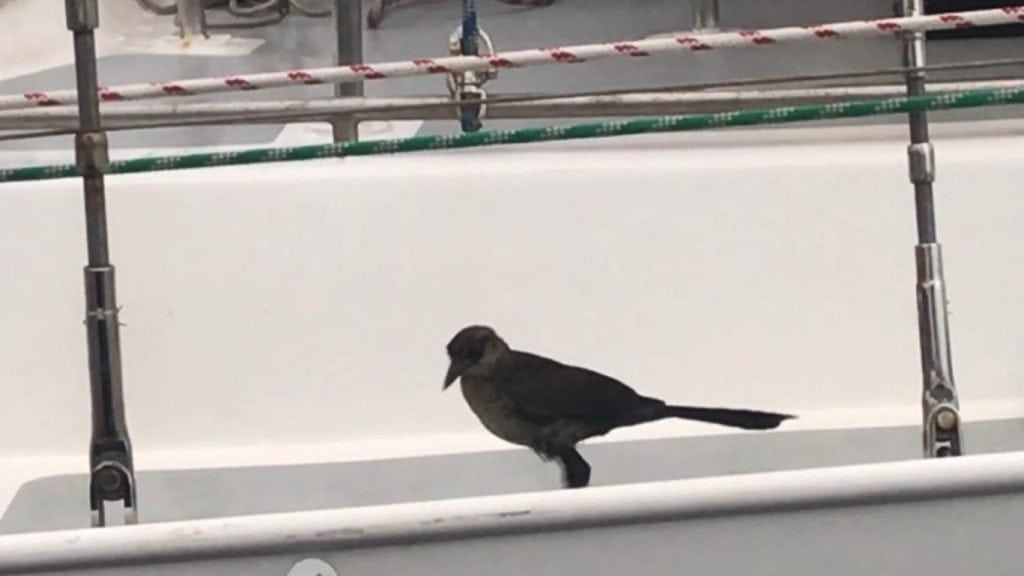
06.21 Everyone is on deck ready for the advisor, but the advisor is late.
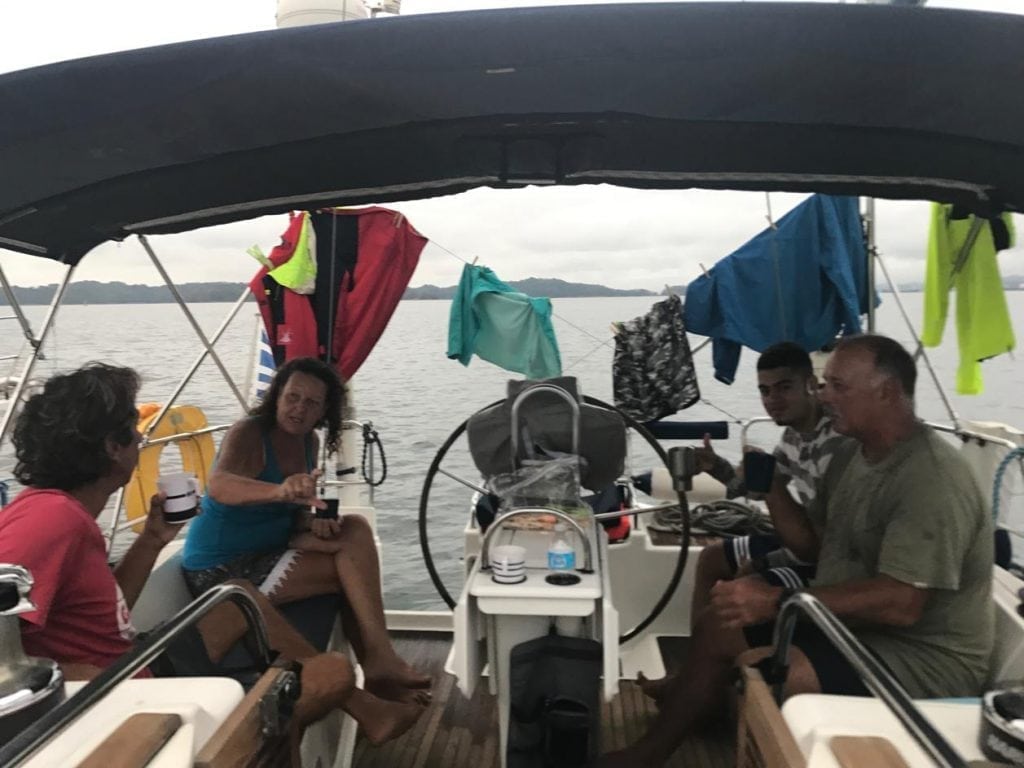
- 00 The pilot boat approaches and the two advisors come onboard, one on Utopia and one of Filizi. Two hours delay, it could have been worse.
-“Good morning. My name is Victor” the man says. He is tall, thin and he has a nice smile.
-“Welcome , Victor, I ‘m Karina. Would you like something to drink?
-“Yes, I’d like a cup of tea”
-“How do you take your tea?” I ask him.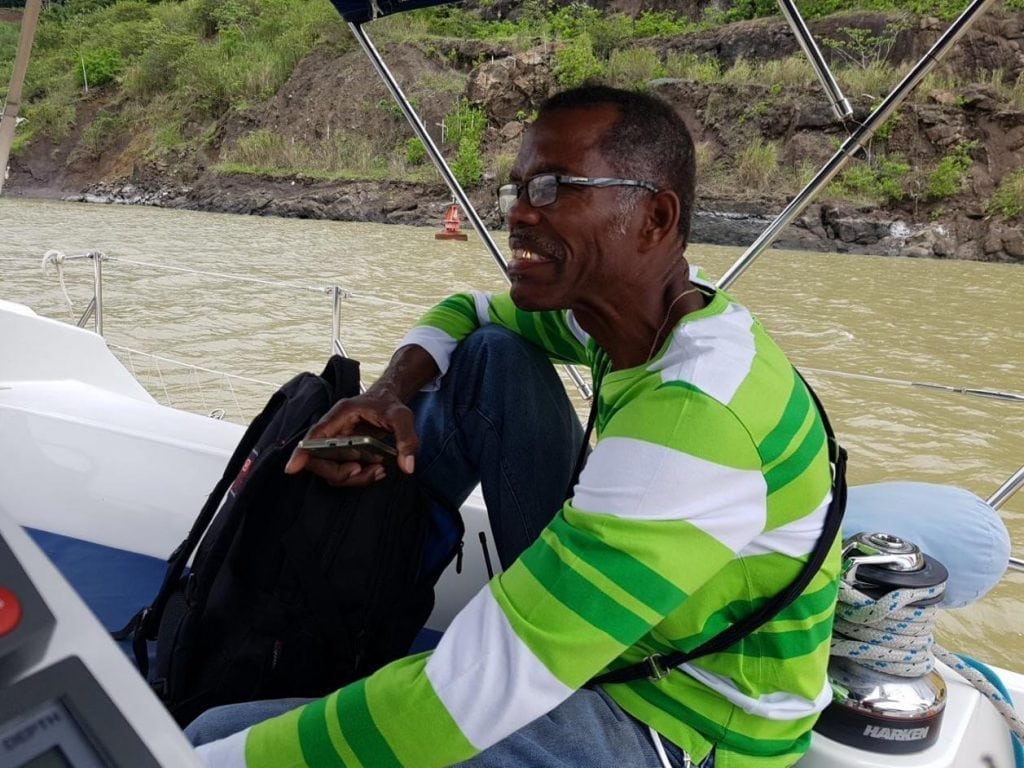
-“If the cup is this size” he says pointing at my empty coffee mug, “I want one sugar. If it’s bigger, I want two” he says with a smile
08.15 We are on our way motoring with a speed of 6,1 knots, as the advisor indicated. It’s a hot day, the sky is cloudy, with an ocasional sunshine and the water temperature is 28,6°!! The nature around the lake is beautiful, exotic plants, palms, blooming trees, flowers all in a superlative grade. 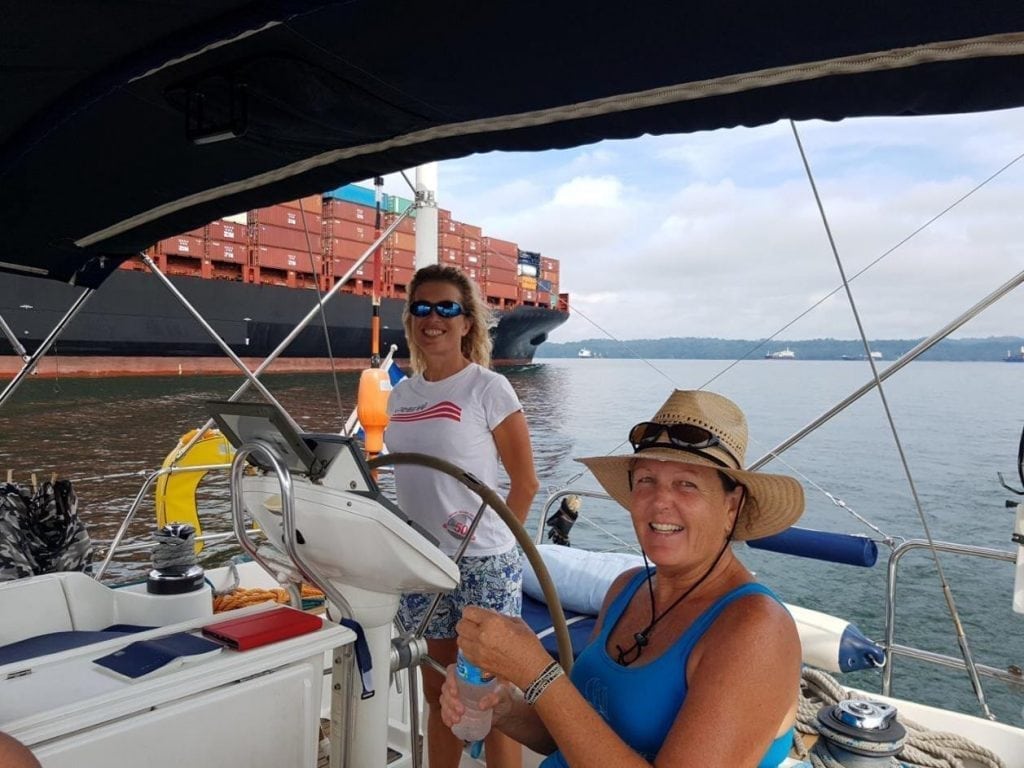 While on the way, I make ham and chese and tuna sandwiches for everyone and later a light meal of scrambled eggs and salad with feta and cherry tomatoes.
While on the way, I make ham and chese and tuna sandwiches for everyone and later a light meal of scrambled eggs and salad with feta and cherry tomatoes.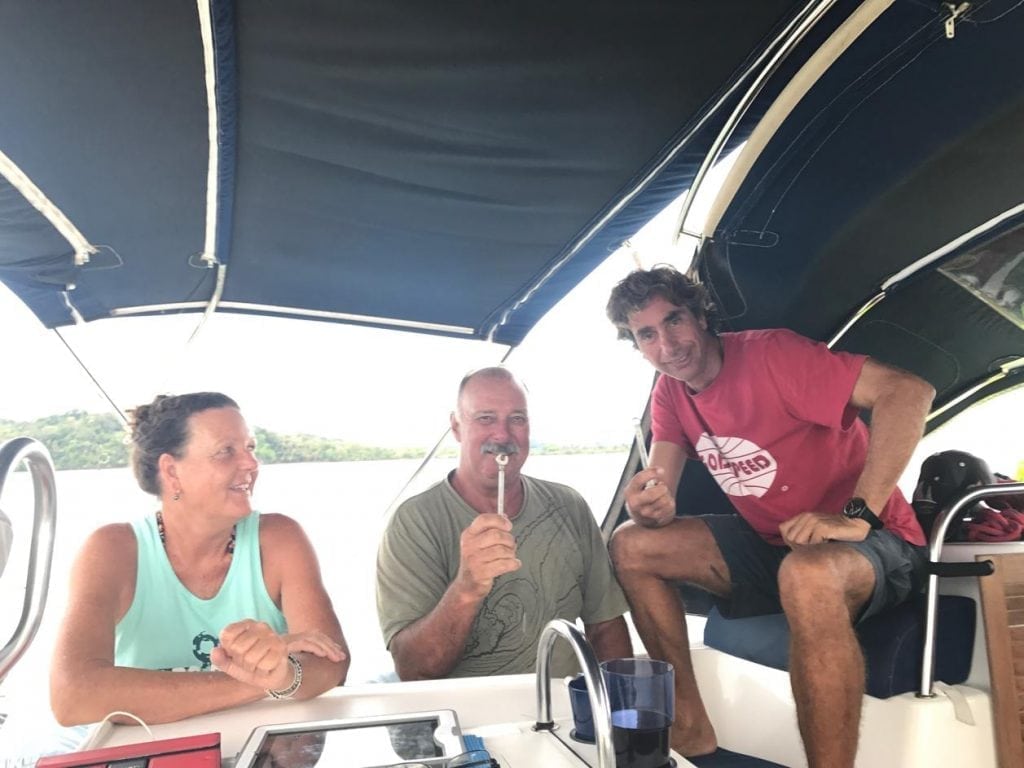
13.00 We catch up with a huge grey ship and for a few minutes, we go side by side at about 80 meters distace from her.. The name of the ship is Galveston Highway. The ship transits with a speed of 5,7 knots and leaves no wake behind it. The sight of the huge ship at this distance is overwhelming, we look like David close to Goliath. The sailors on board the ship, salute us. As we have a speed of 6,1 knots, we soon start to overcome her. Then, Yorgos notices that the ship gains speed, and we go side by side again, for the next 3 minutes. Since we can’t overcome the giant, Galveston highway, Yorgos cuts down our speed to 4,7 kts to stay behind but then, the ship cuts down her speed, too, and we are at her starboard side, again! It’s obvbious that all this, does not happen by chance. Captain Yorgos, on an effort to stay away from the ship, speeds up to 6,5 knots and we start to overcome again. As we reach the starboard bow side of the ship, she blows her horn five times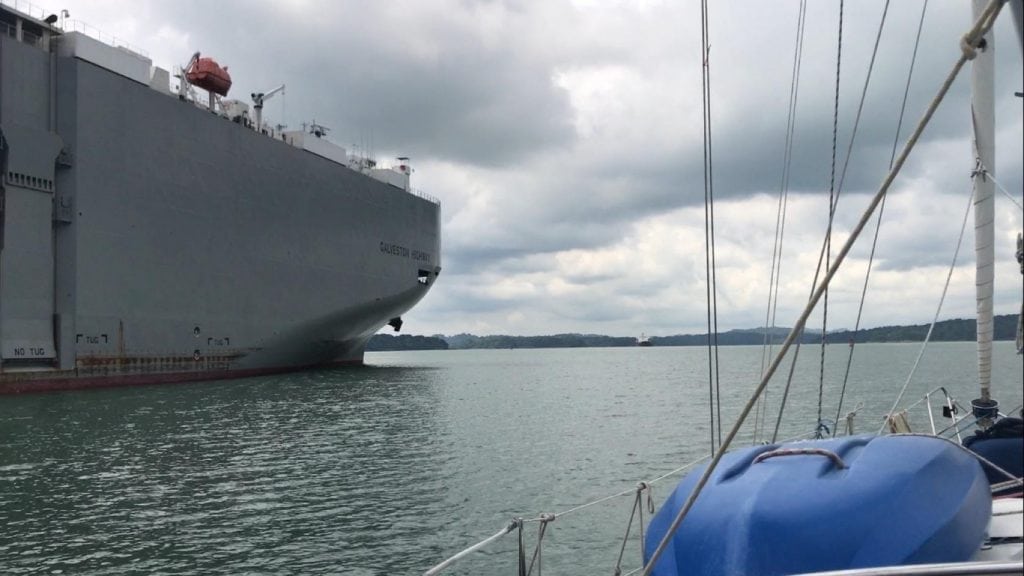
-“ Victor, do you think she blows the horn for us?” Yorgos asks the advisor
-“I don’t know why…”, Victor says and then we hear a voice on the advisor’s handheld VHF, that uses the special frequency of Panama Canal.
-“Take your precautions, take your precautions! You are dangerously near us. You almost hit us…” says the pilot of the big ship!!!
Victor our advisor is worried, because the pilots outrank the advisors. We all hope he doesn’t have trouble for that.
12.00 We enter the narrow passage called the “Culebra Cut, a 12,6 km (7,8 miles) channel between Gatun Lake and Pedro Miguel Lock. Culebra is the name of the mountain ridge that the water passage cuts through. The Culebra Cut was previously know as “Gaillard Cut”, after U.S. major Gaillard, who led its excavation. When the United States handed control of the Canal to the Panamenians, in 1999, the Cut took it’s original name. The challenging excavation of the Cut begun by the French venture in 1881, that was led by the legendary Ferdinand de Lesseps, creator of the Suez Canal. The French, who planed on making a sea level channel, underestimated the difficulty of the excavation, which led to the financial collapse of the venture. In 1904, the United States took over the project and major Guillard was put in charge of the excavation between Gatun lake and Pedro Miguel Locks
-“ You see this hill over there, Karina? It is named the Pico de Oro, the peak of gold. Back when the canal was being excaveted, many people were dying of desease and the canal people, had trouble in finding workers. Then, someone had the …brilliant idea, to plant some gold on the hill and spread the word around. Those where the times of the Gold Rush in California, and people whould travel to the end of the world for a chance to get rich. People came for all ove the world, and the mountain was called Pico de Oro. The trick worked and people started digging for free for a while, but of course after some months they realised there was no gold there…” Victor says.
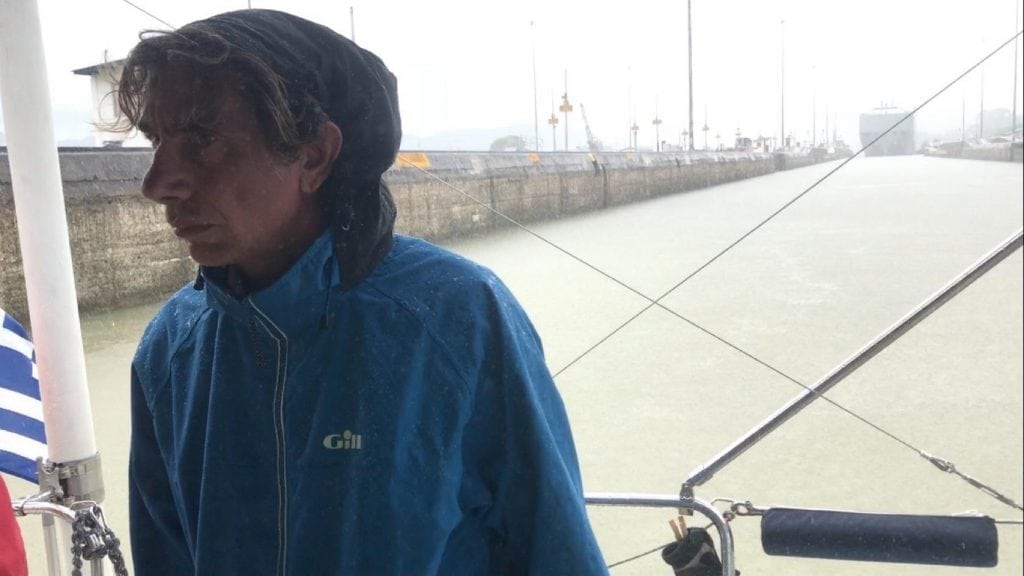 13.09 As we approach the entrance of Pedro Miguel locks, heavy clouds cover the sky. By 13.15 a pouring rain is falling.
13.09 As we approach the entrance of Pedro Miguel locks, heavy clouds cover the sky. By 13.15 a pouring rain is falling.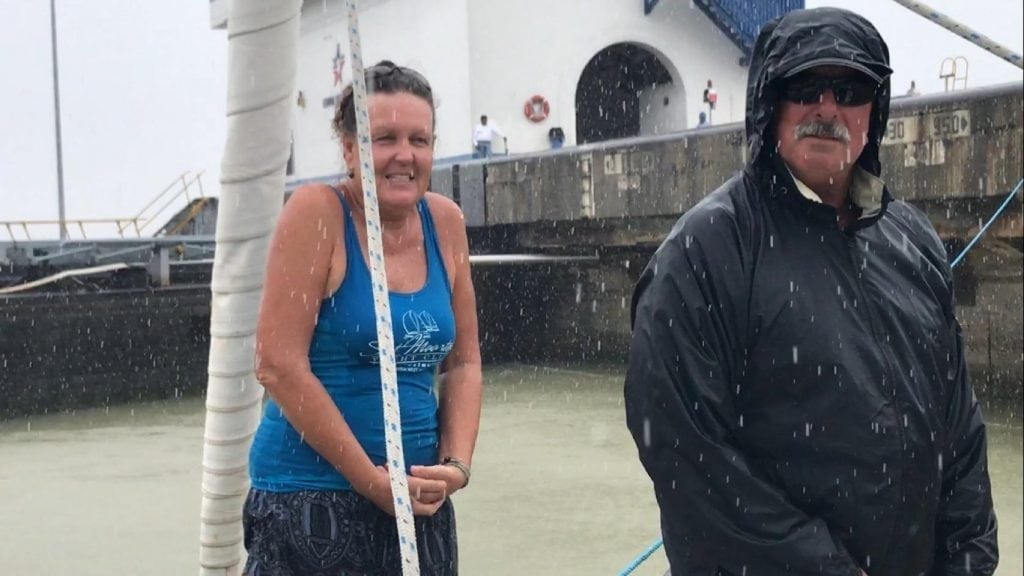
-“For this transit, Filizi, Utopia and the sailboat Milly will be “nested” all together. The vessel Utopia, as it is steel and therefore heavier will be in the middle and Filizi on her starboard (right) side”, Victor explains after he talks with the advisors on the other two sailboats, on his VHF. All boats come close. We tie with Utopia with aft, bow and spring lines. S/v Milly ties on Utopia’s port side.
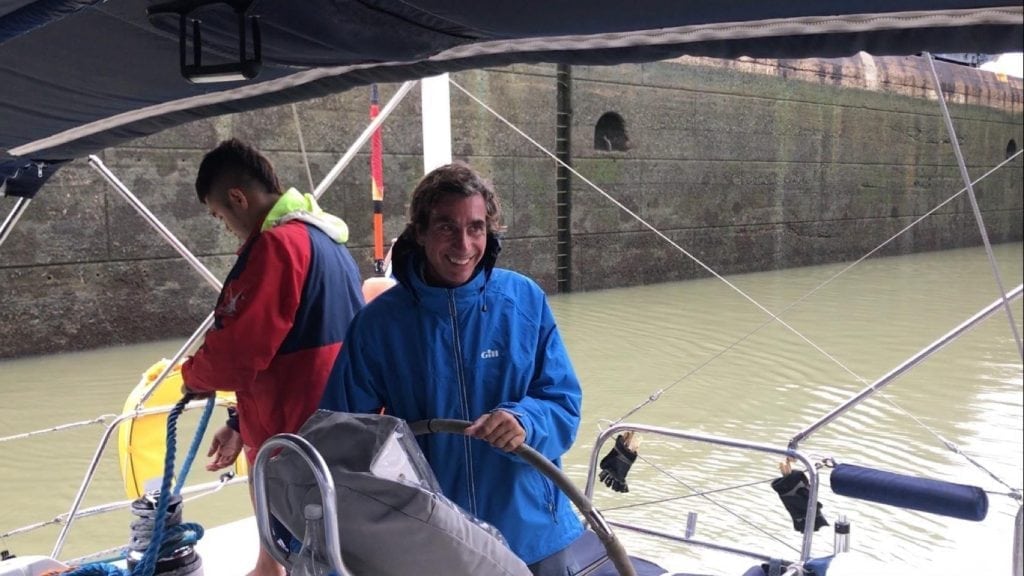 On the starboard side of Filizi John, Frances and Juan set the long blue lines bow and aft. Then, the handlers on the channel walls throw us thin lines with “monkey fists”. John and Juan, tie our long blue line with the “monkey fists” and the handlers on the walls pull the lines ashore and take control of all three boats.
On the starboard side of Filizi John, Frances and Juan set the long blue lines bow and aft. Then, the handlers on the channel walls throw us thin lines with “monkey fists”. John and Juan, tie our long blue line with the “monkey fists” and the handlers on the walls pull the lines ashore and take control of all three boats.
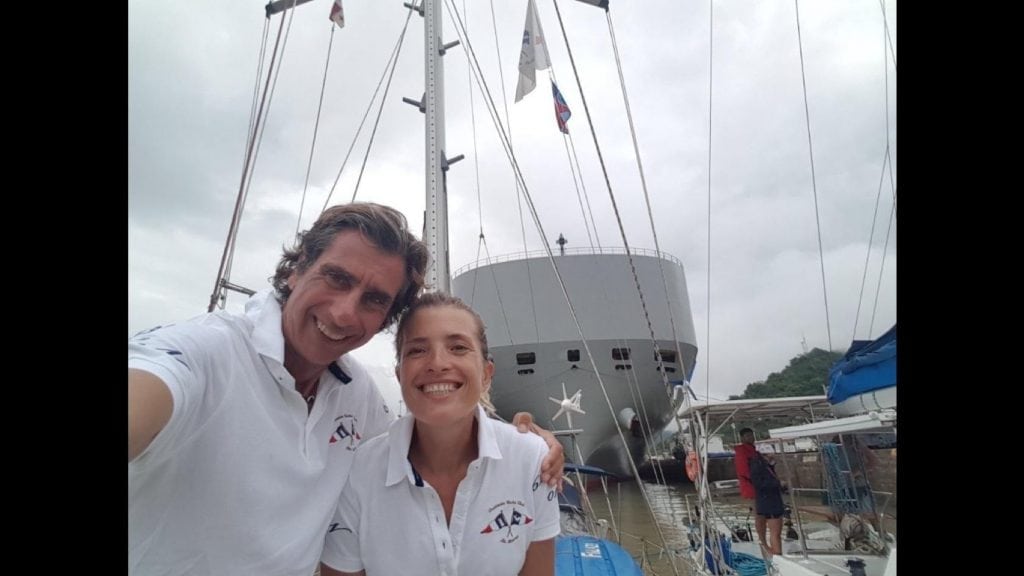 The huge ship Galveston Highway approaches behind us. We are now inside Pedro Miguel Lock and the huge doors close slowly behind us.
The huge ship Galveston Highway approaches behind us. We are now inside Pedro Miguel Lock and the huge doors close slowly behind us.
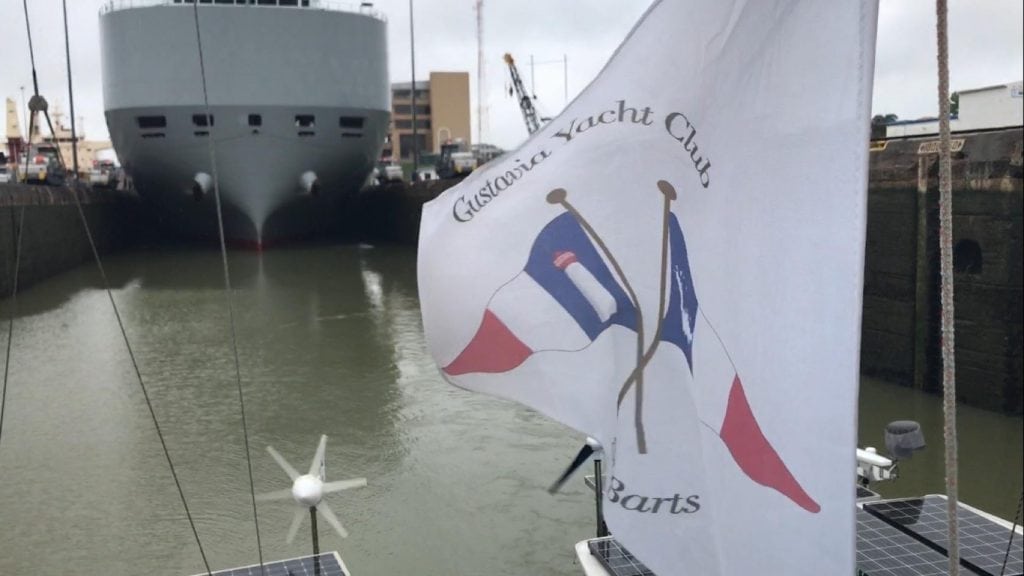 The lock starts emptying water, to reach the next level.
The lock starts emptying water, to reach the next level.
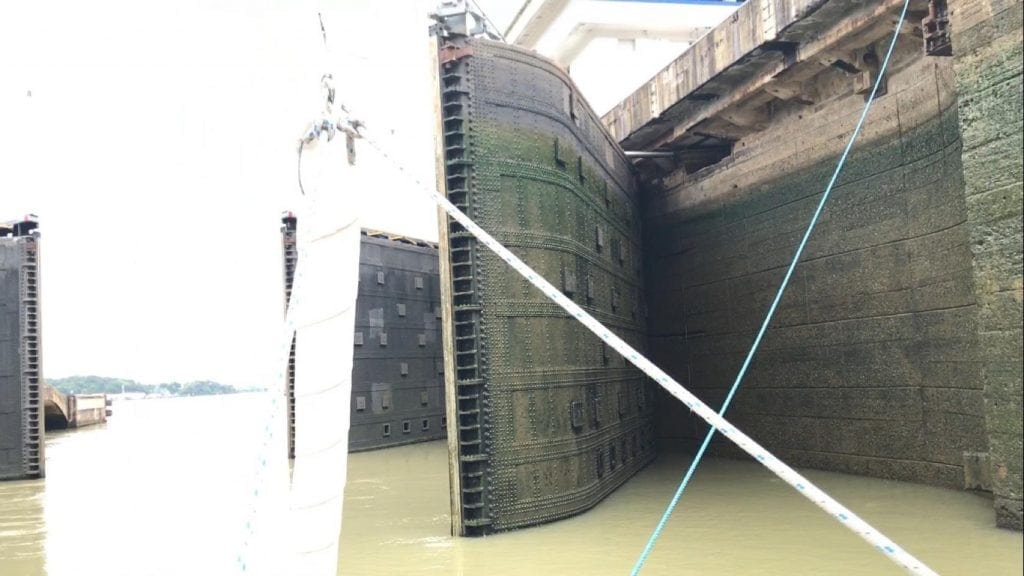 As we wait, the rain is pouring and poor Francis is soaking wet and we joke about the couple’s wet t-shirts transit. They are such nice people, and never complain!! After a ften minutes, the level has dropped about nine meters. A bell starts ringing and the doors slowly open.
As we wait, the rain is pouring and poor Francis is soaking wet and we joke about the couple’s wet t-shirts transit. They are such nice people, and never complain!! After a ften minutes, the level has dropped about nine meters. A bell starts ringing and the doors slowly open.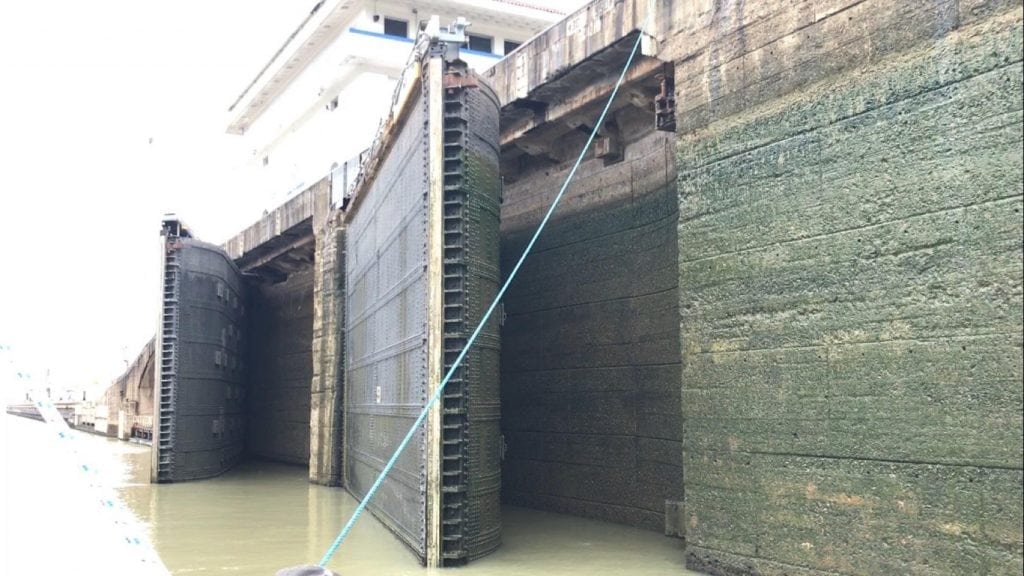
Being close and with the daylight this time, we all watch with admiration two sets of magnificent, steel doors opening. The sight is spectacular. When they are wide open they fit so completely and perfectlly in the wall, that they practicaly disappear!
14.30 We are in the Miraflorres locks and thankfully the rain stops. We slowly approach the Miraflores Visitor Cente building, one of the main touristic attractions for tourists in Panama.
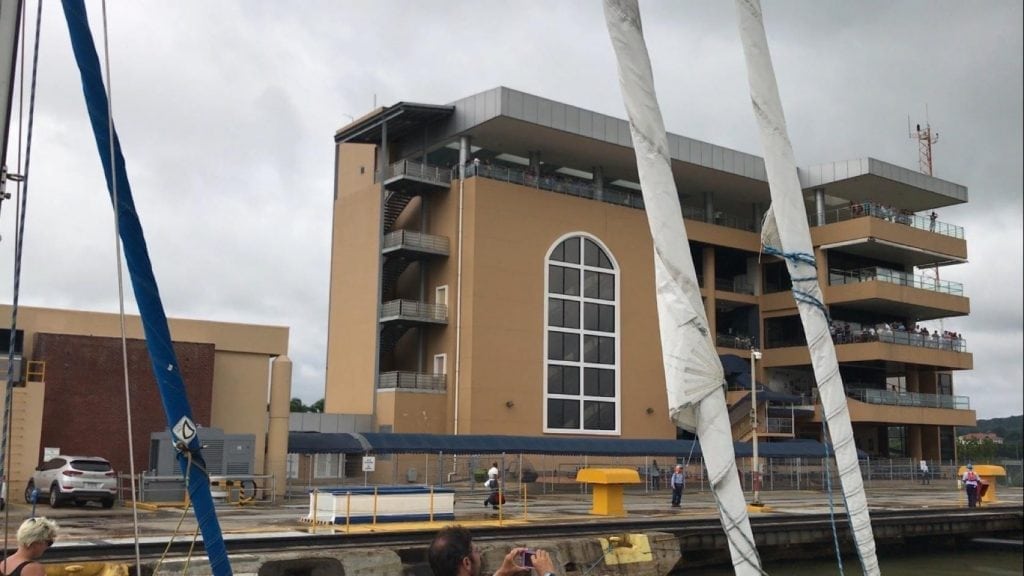 The view from up here is fantastic, we can now see the Pacific Ocean, 600 meters further and about 20 meters lower.
The view from up here is fantastic, we can now see the Pacific Ocean, 600 meters further and about 20 meters lower.
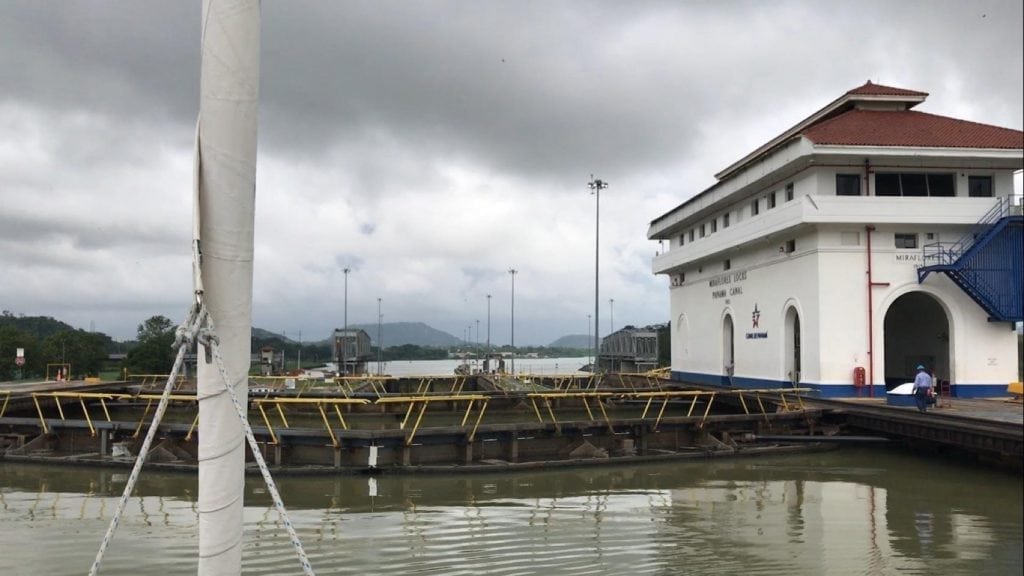 The spirits are really high as we talk with the wonderful people on Utopia boat, Marco and Lucia and we agree to meet again some day, in French Polynesia.
The spirits are really high as we talk with the wonderful people on Utopia boat, Marco and Lucia and we agree to meet again some day, in French Polynesia.
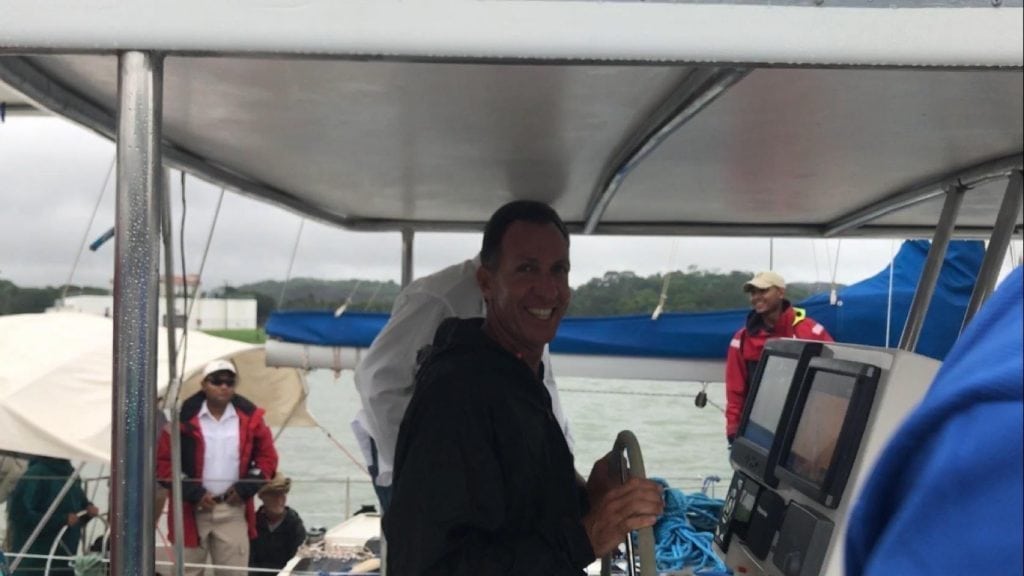 The doors behind us close and the water level starts dropping. Soon we can’t see the ocean, but only the huge doors ahead.
The doors behind us close and the water level starts dropping. Soon we can’t see the ocean, but only the huge doors ahead.
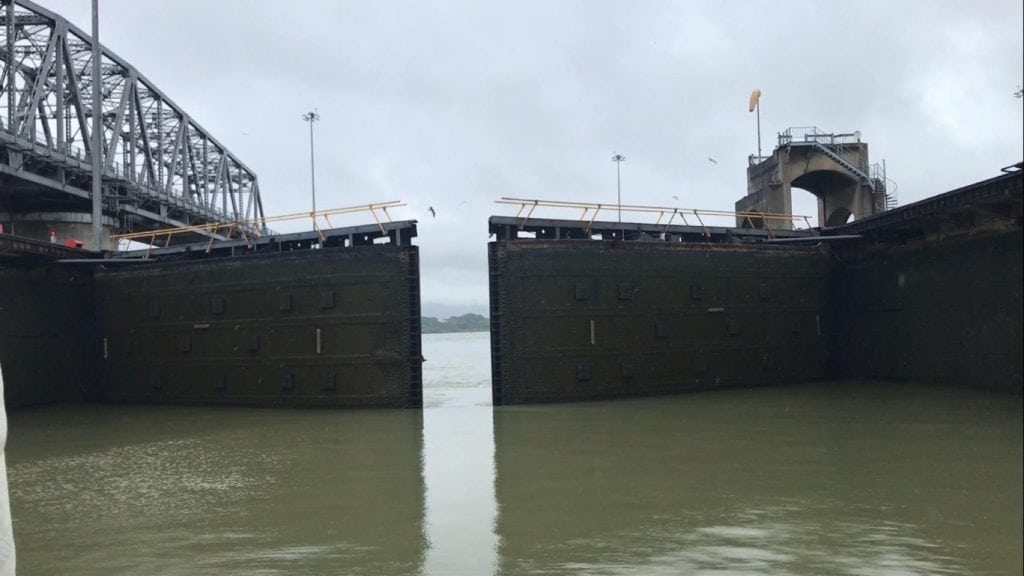 One more lock to go…15.42 The doors of the second Miraflores Lock open and Filizi enters the Pacific Ocean! Captain Yorgos on the helm has a bright smile on. We embrace and hold each other tight for a minute. The boats untie all ropes and we proceed towards Balboa port, passing under the famous Bridge of the Americas, the bridge that unites the North and the South American continent.
One more lock to go…15.42 The doors of the second Miraflores Lock open and Filizi enters the Pacific Ocean! Captain Yorgos on the helm has a bright smile on. We embrace and hold each other tight for a minute. The boats untie all ropes and we proceed towards Balboa port, passing under the famous Bridge of the Americas, the bridge that unites the North and the South American continent.
All the team was great. Thank you Juan, thank you Frances, John, Regie and Victor. You’ve been all amazing.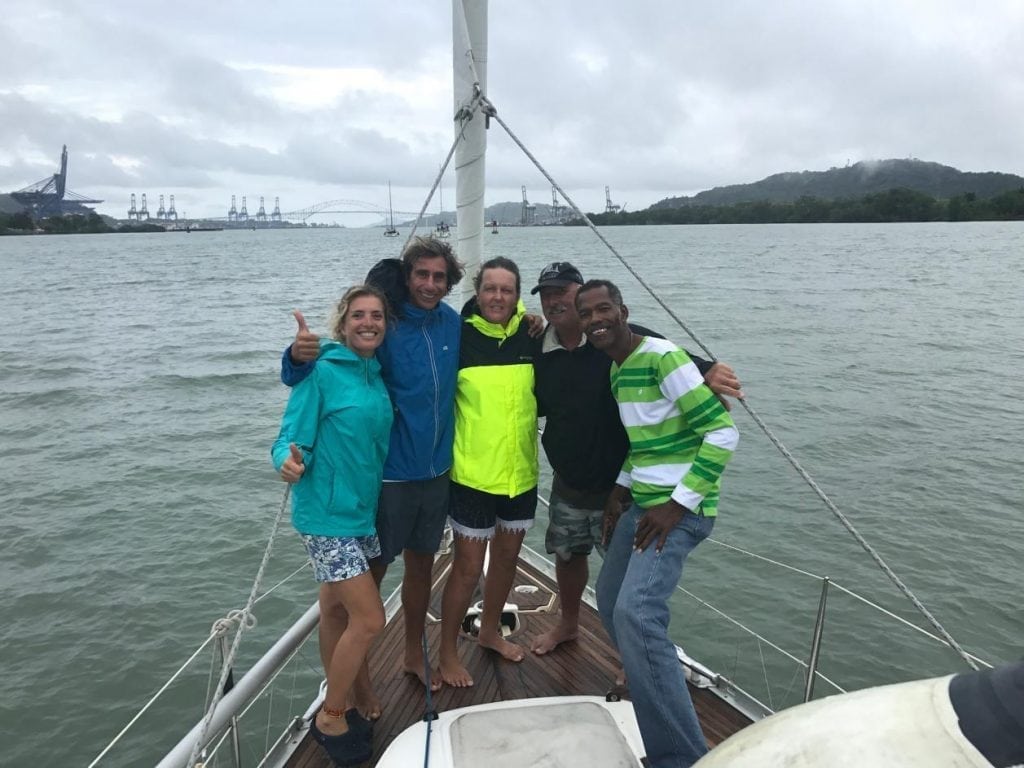
In a few days we’ll be sailing to the Galapagos islands. The great voyage begins here…
08°56.521 N 79°33.620 W

Very nice post! Keep doing
…και τελικα το Filizi εβρεξε και τις δυο Καρινες του με νερο του Ειρηνικου…
Πολυ χαρηκα την ιστορια, τις φωτογραφιες και την μεταφορα των συναισθηματων σας..
Πολλα φιλιά, να περνατε παντα καλα, Κωστας απο Χανια.